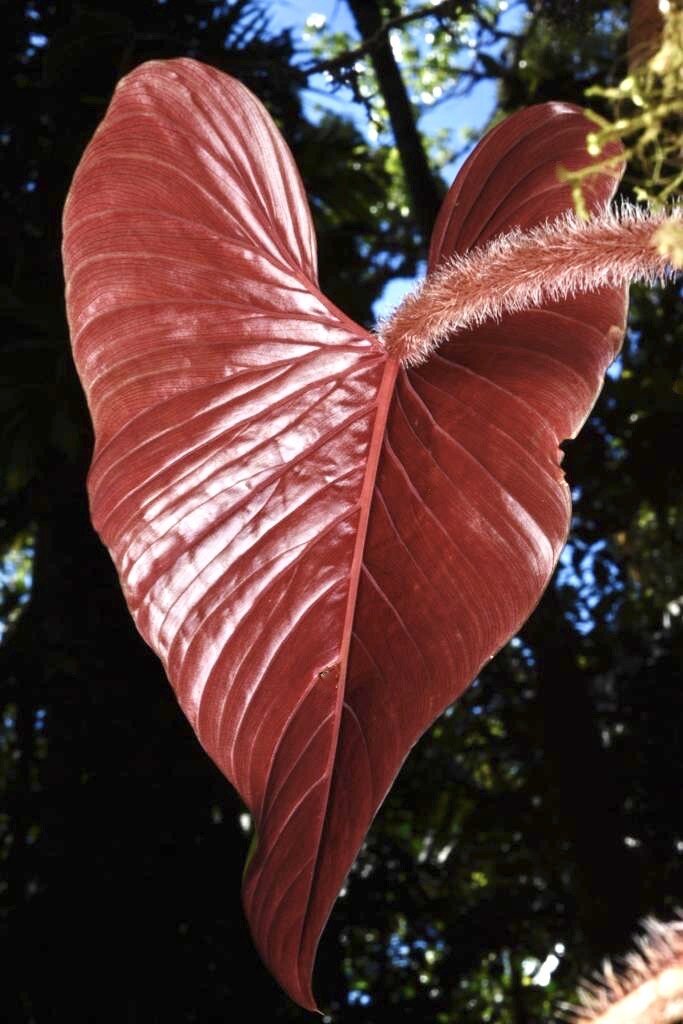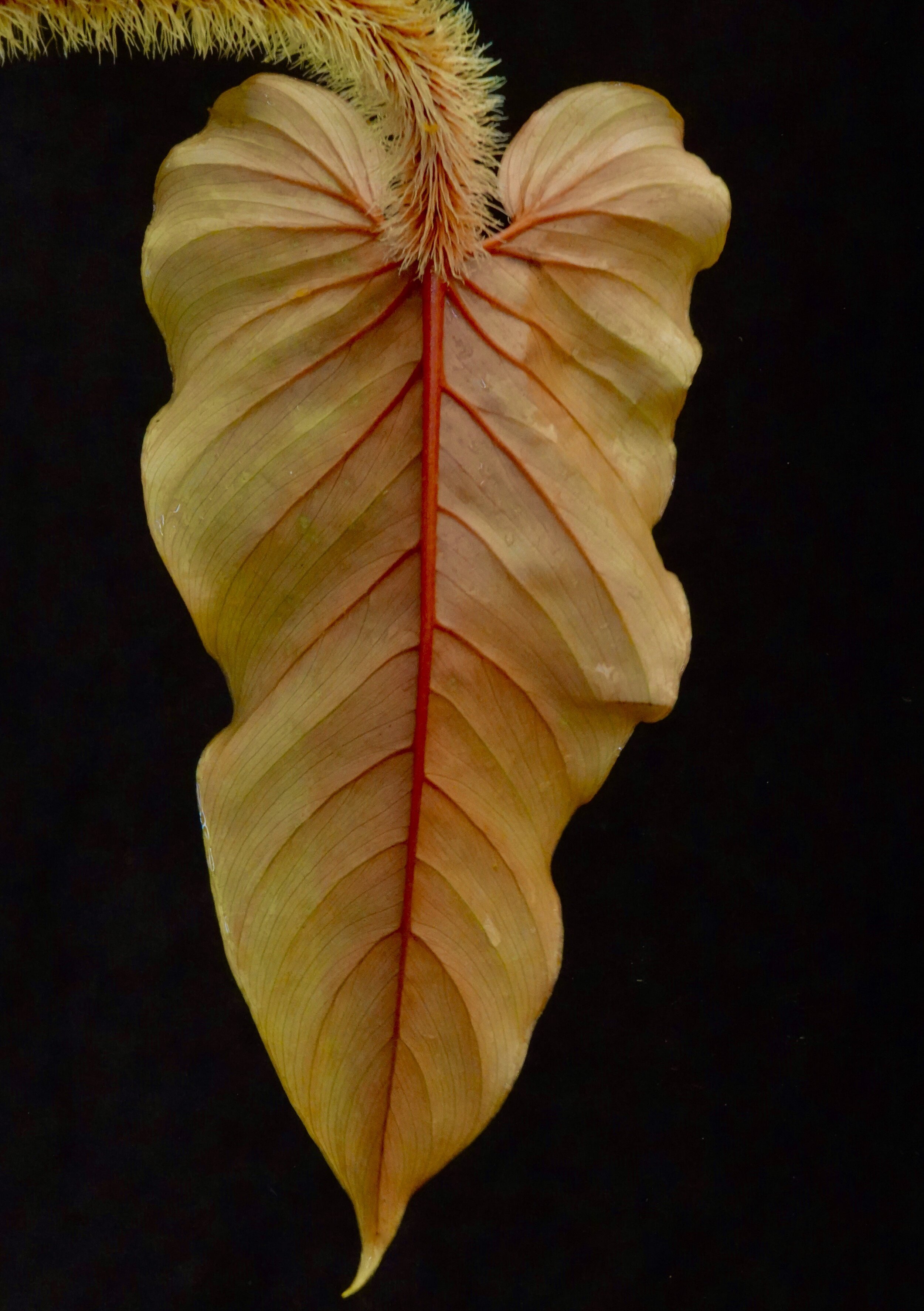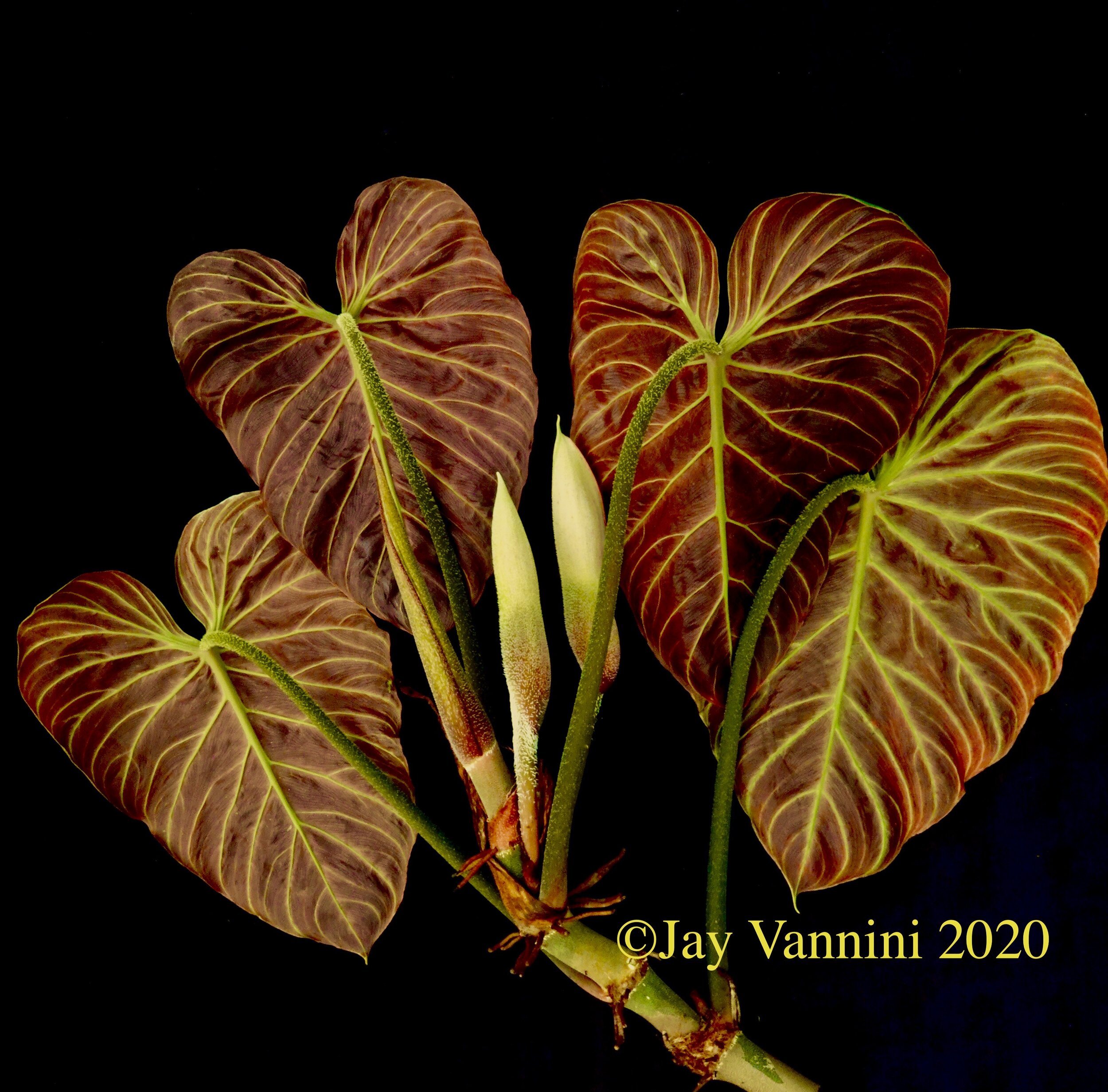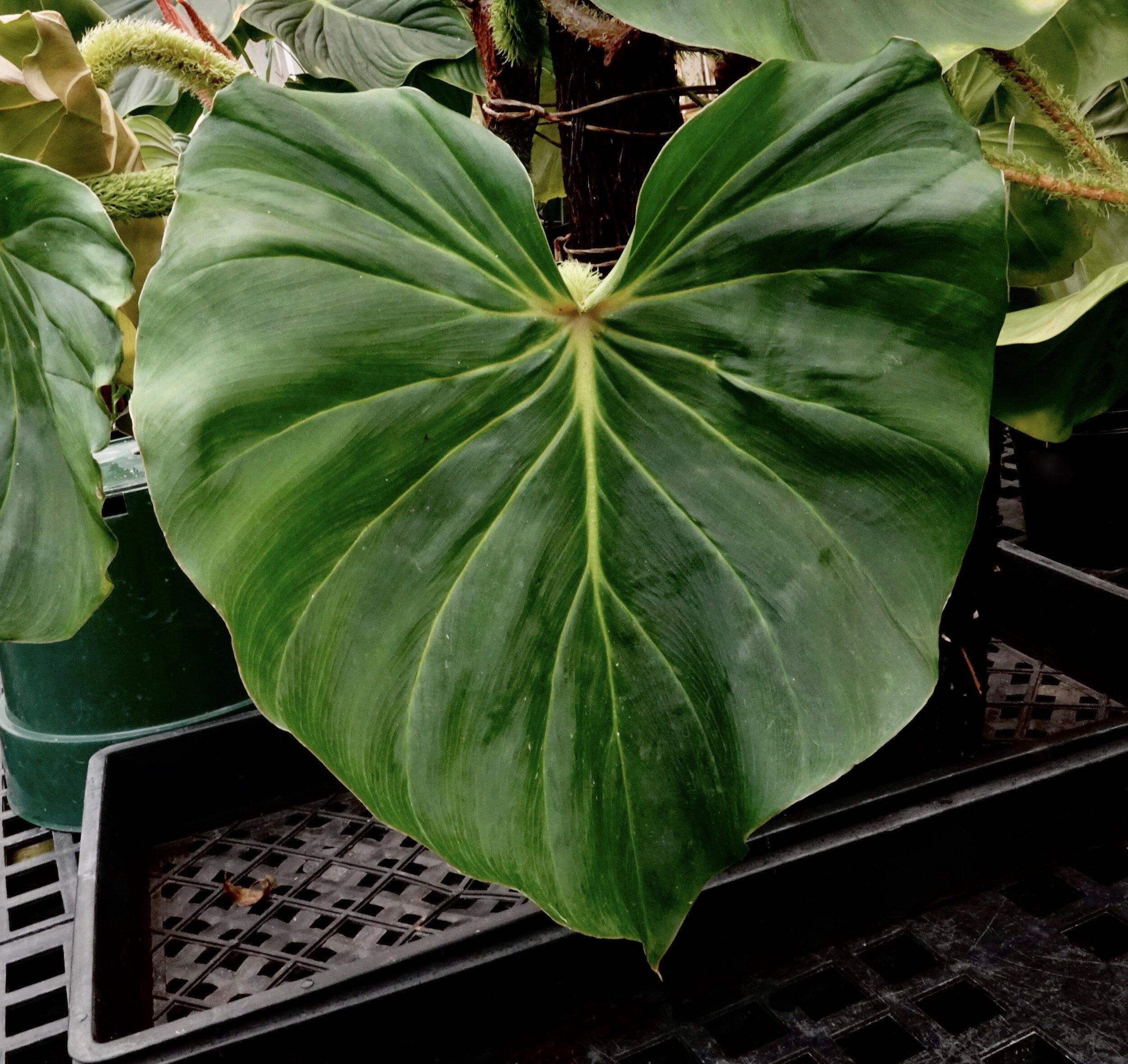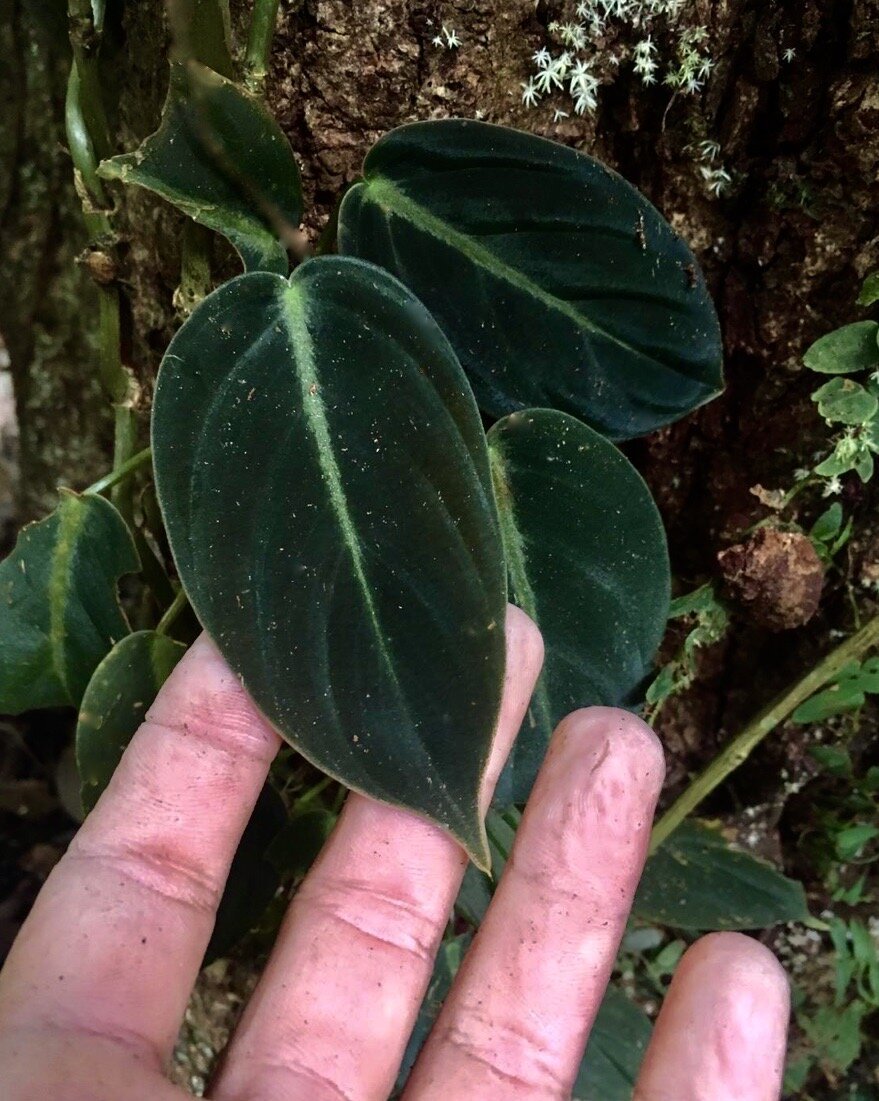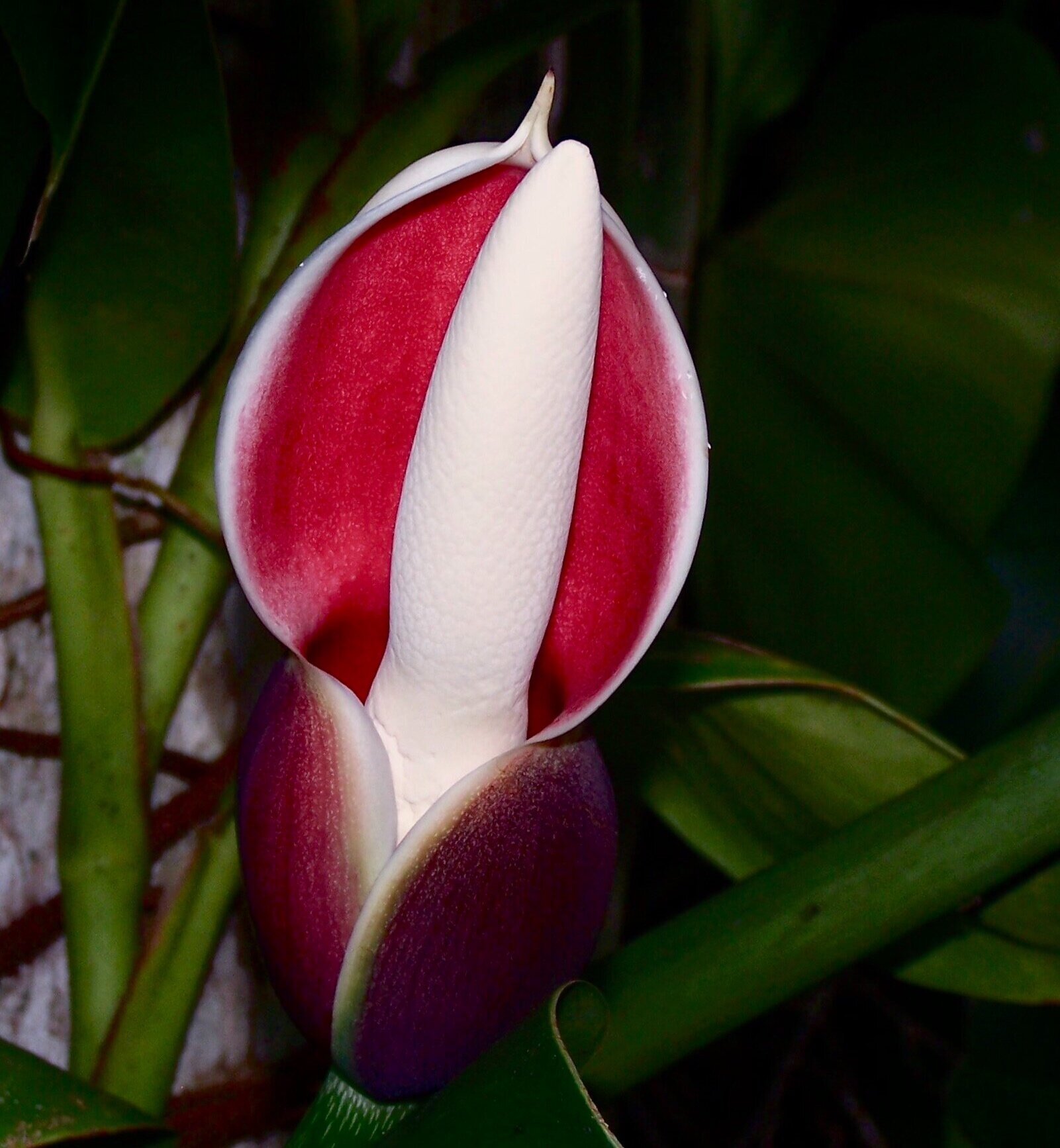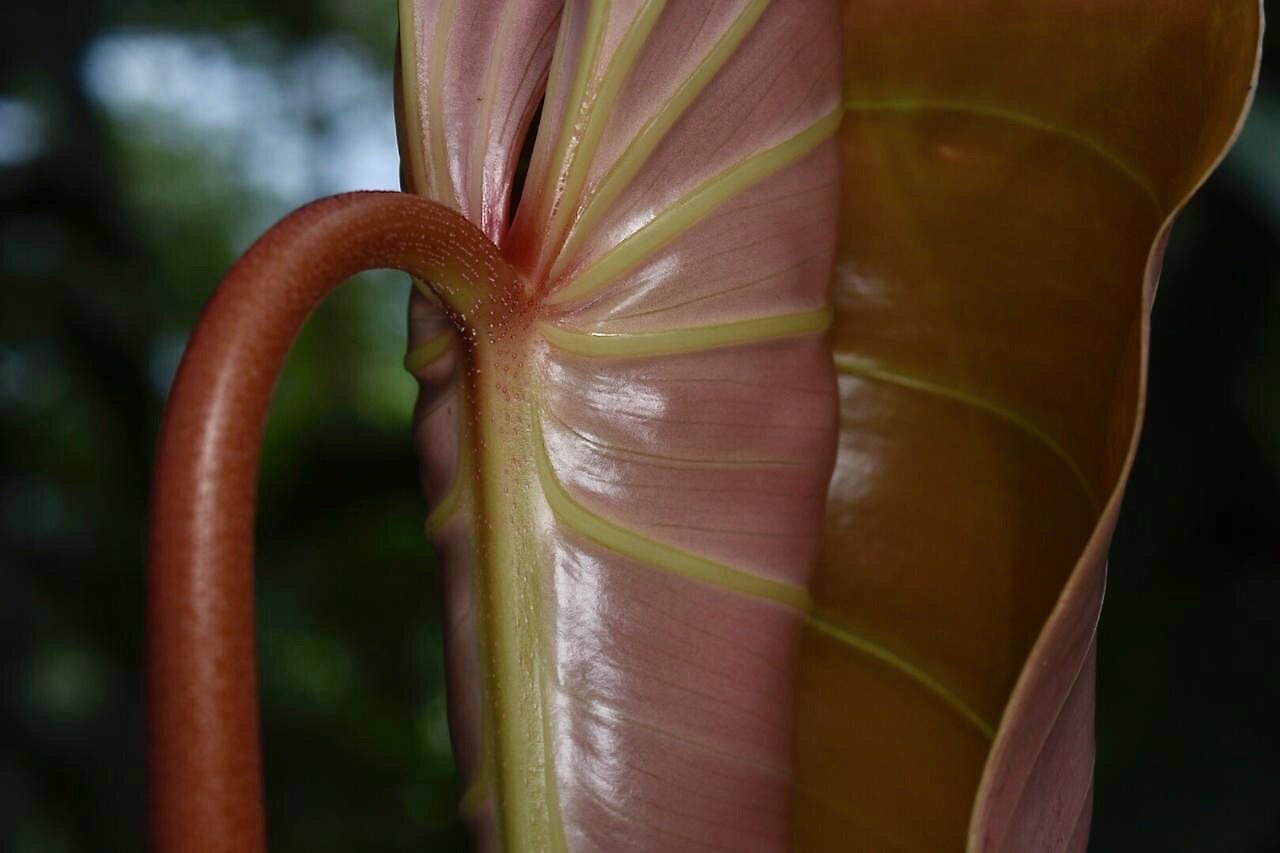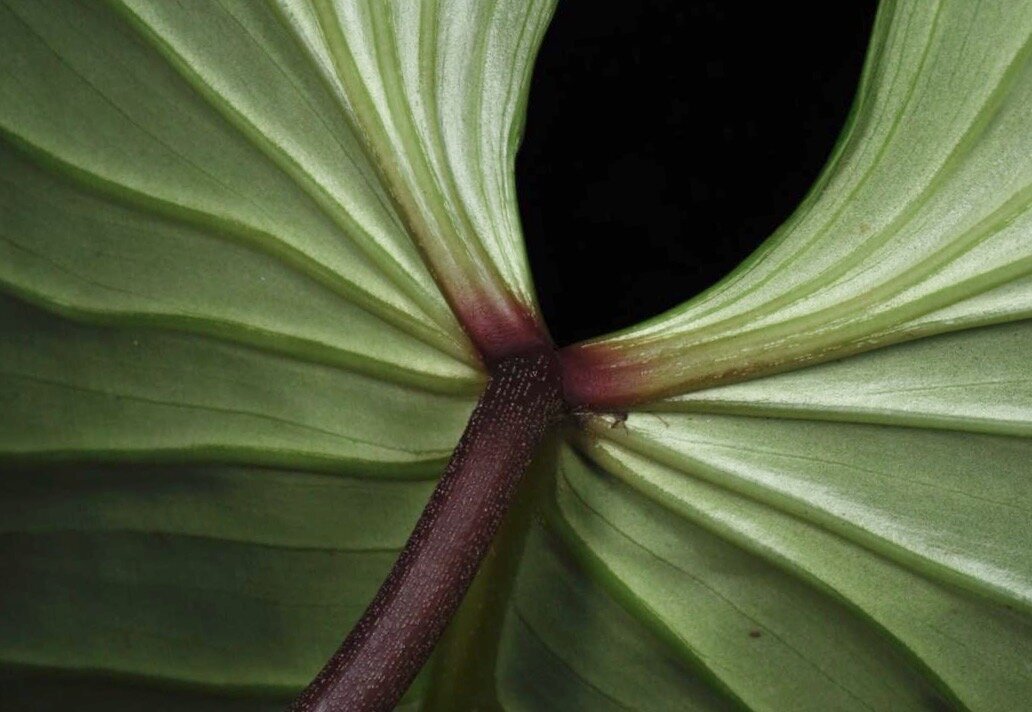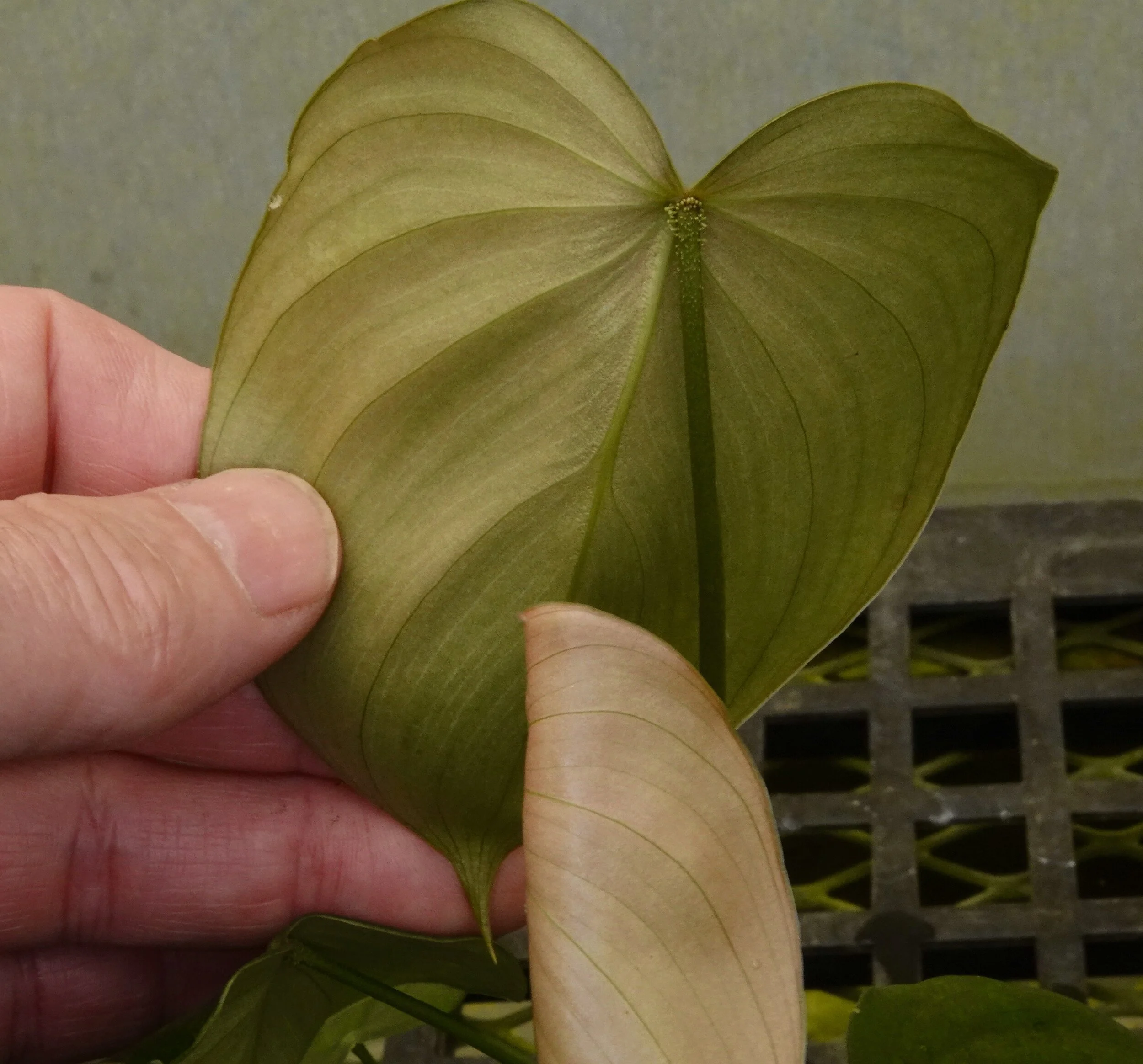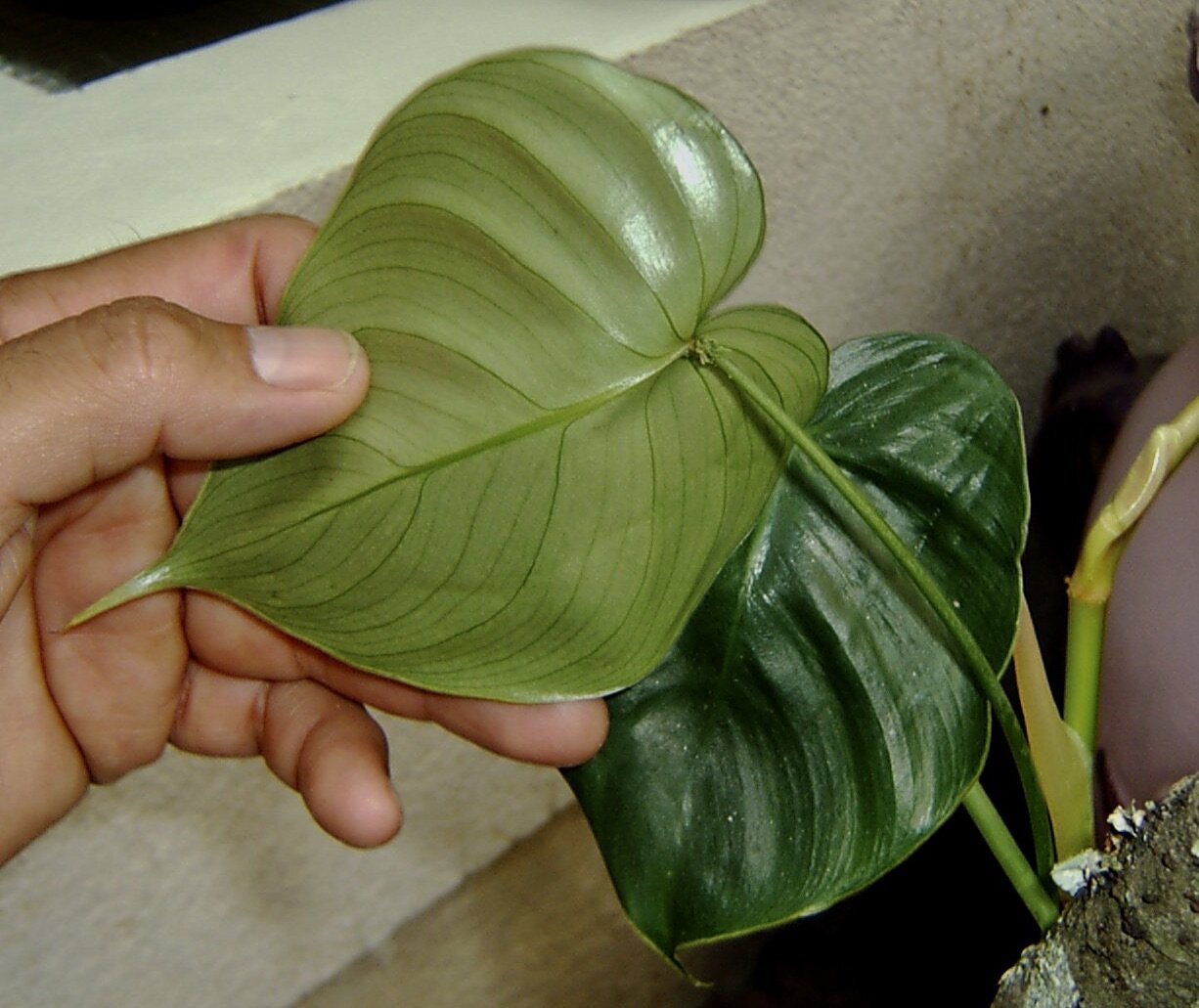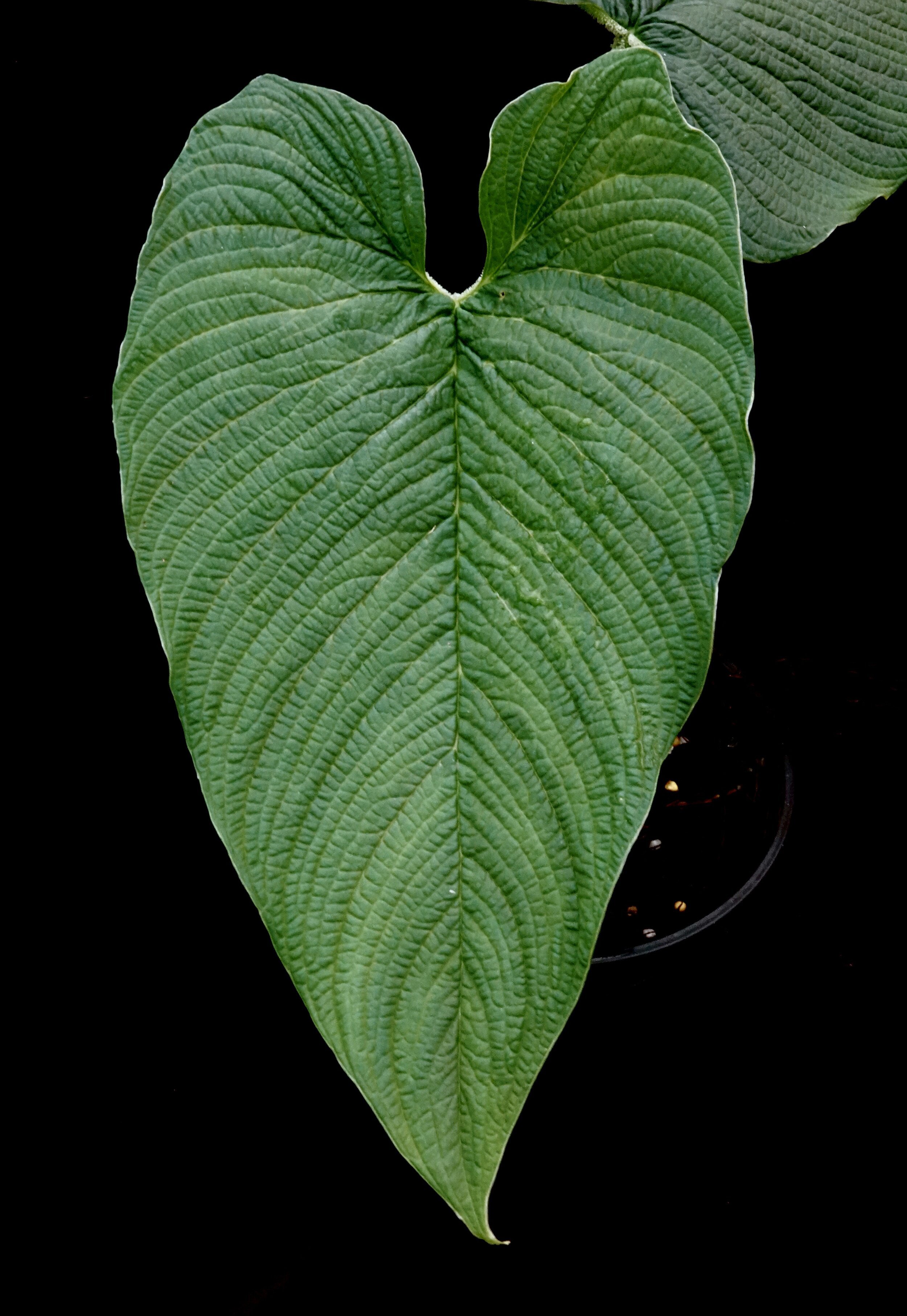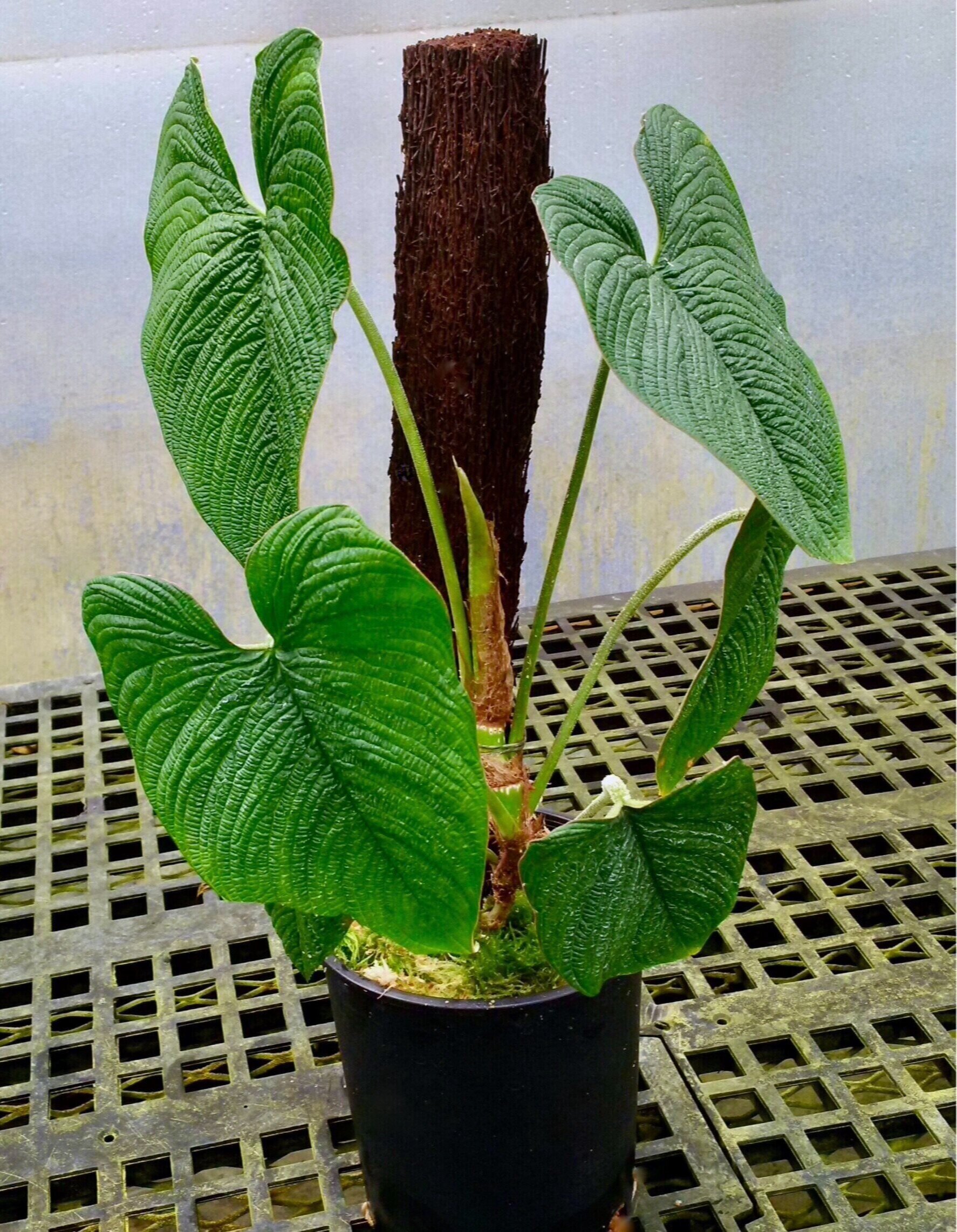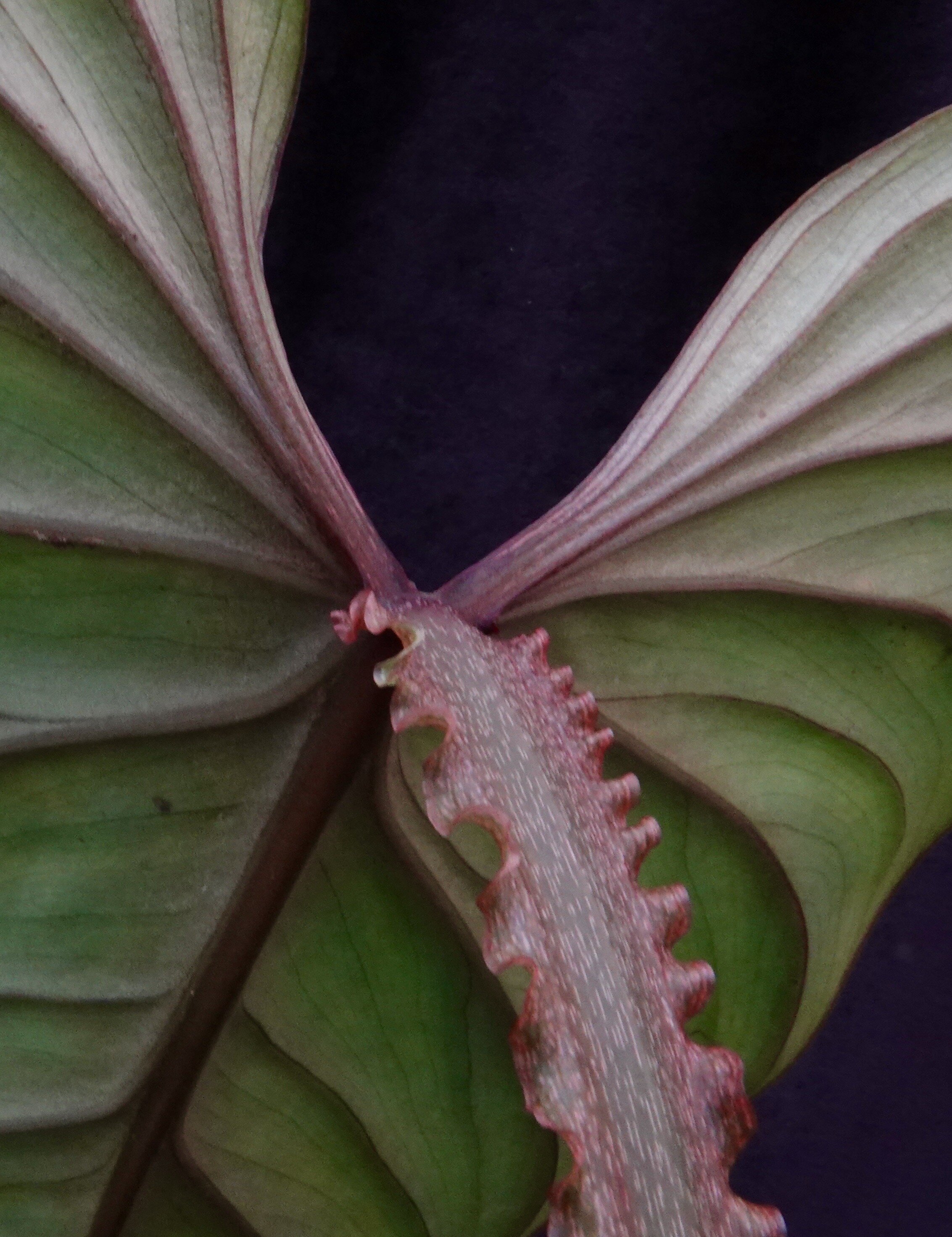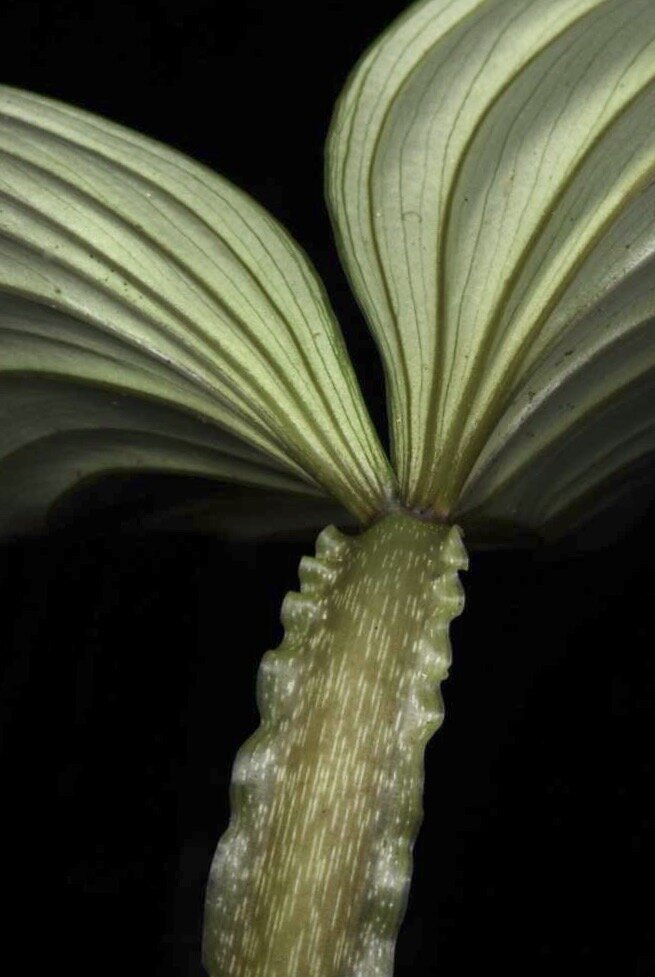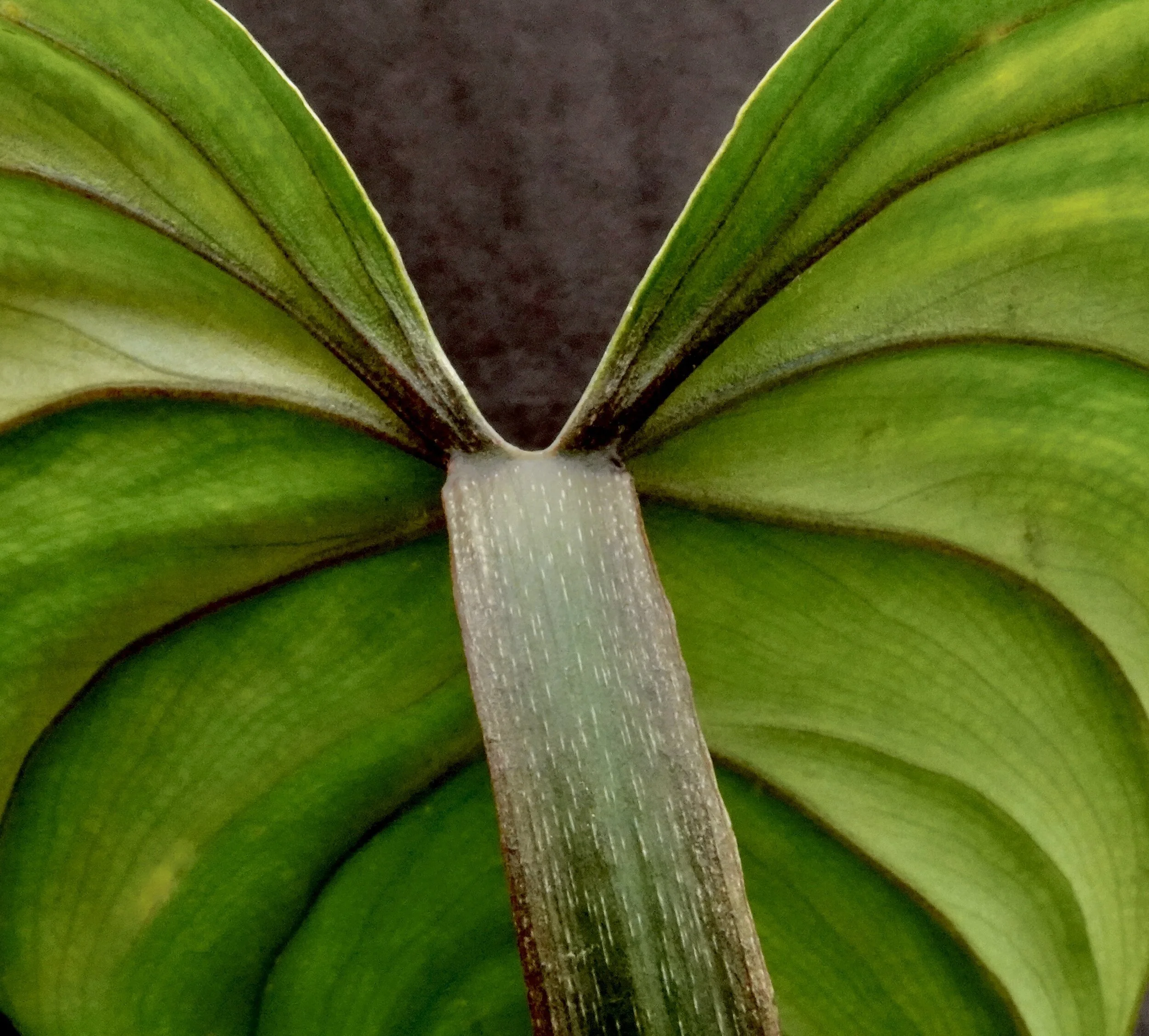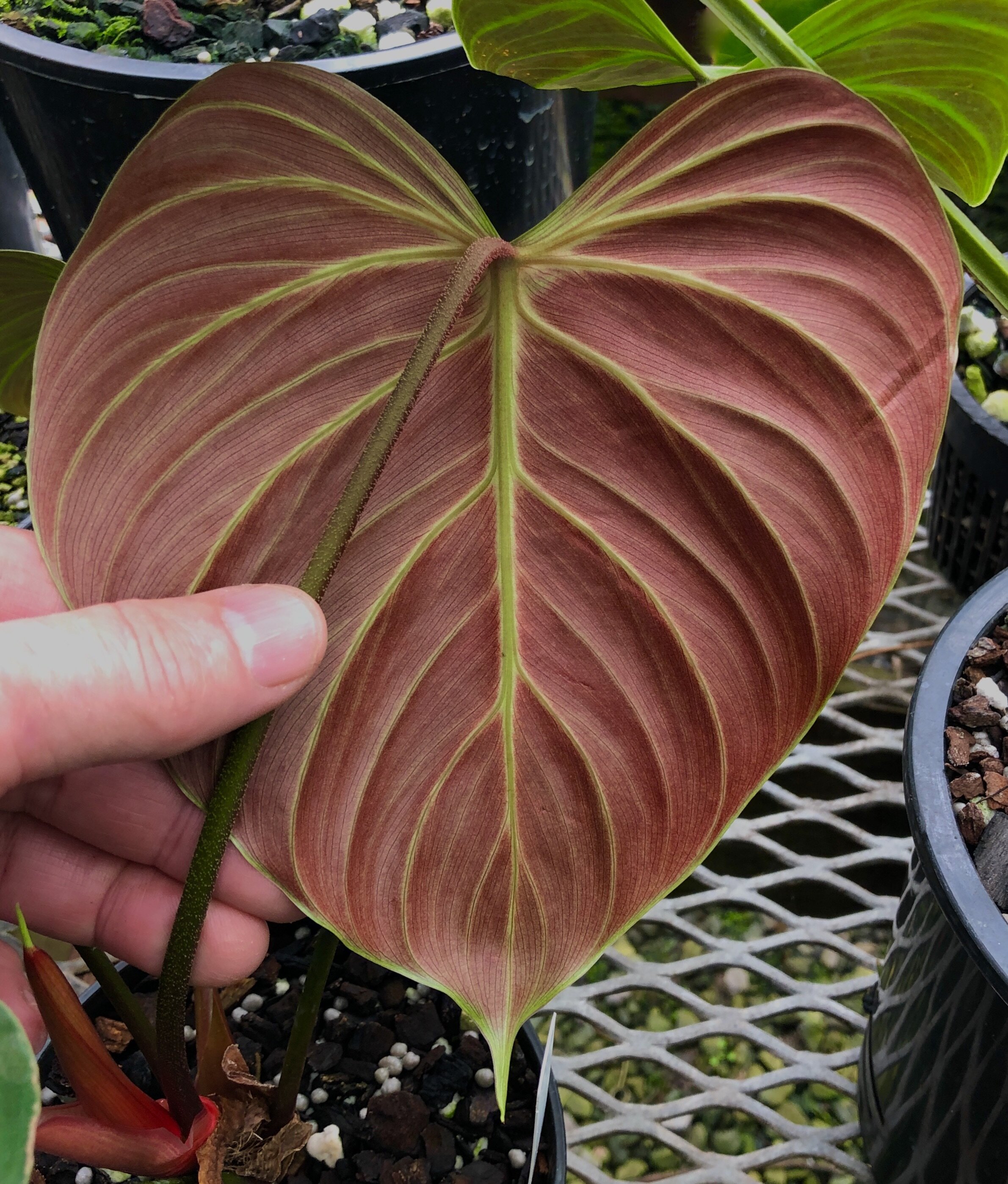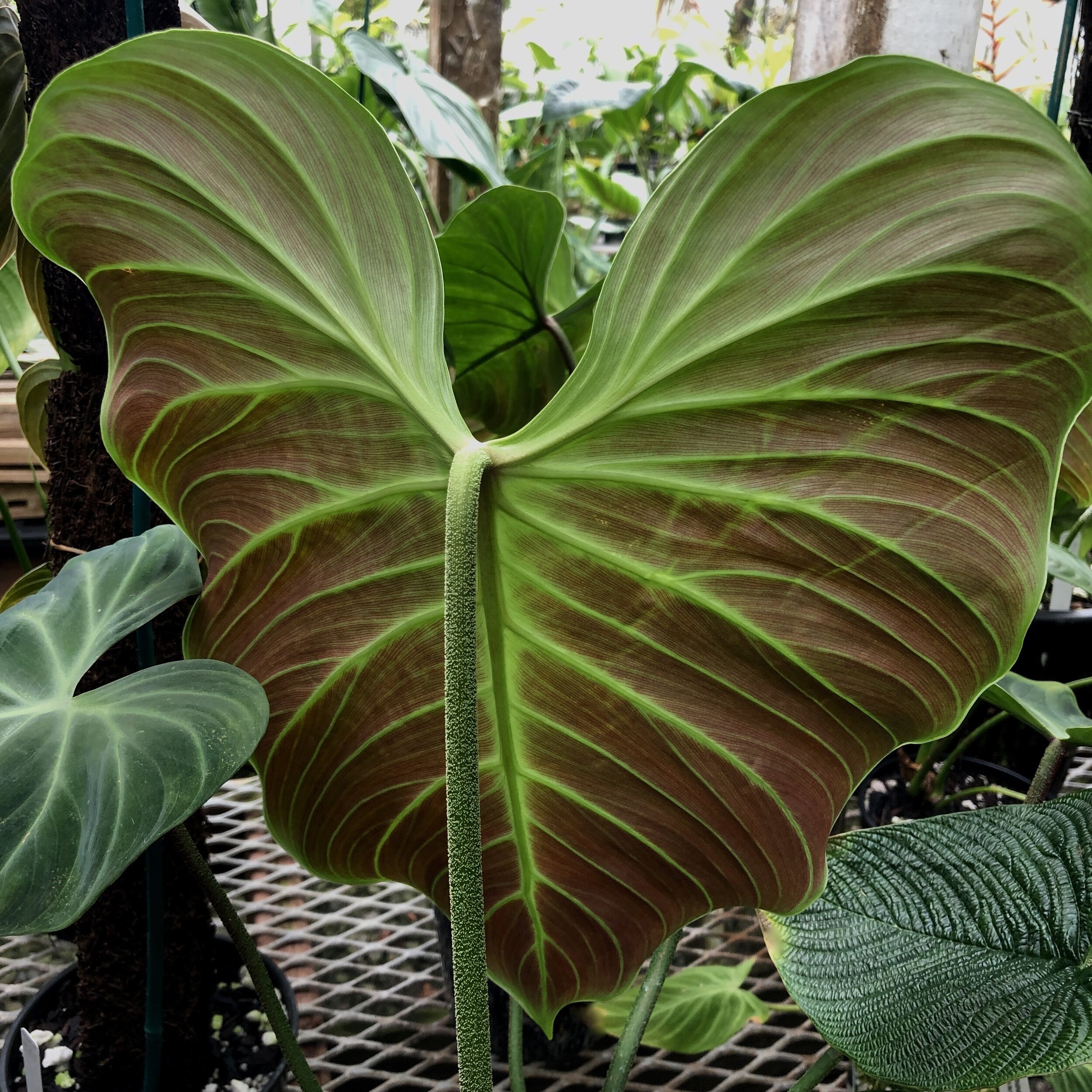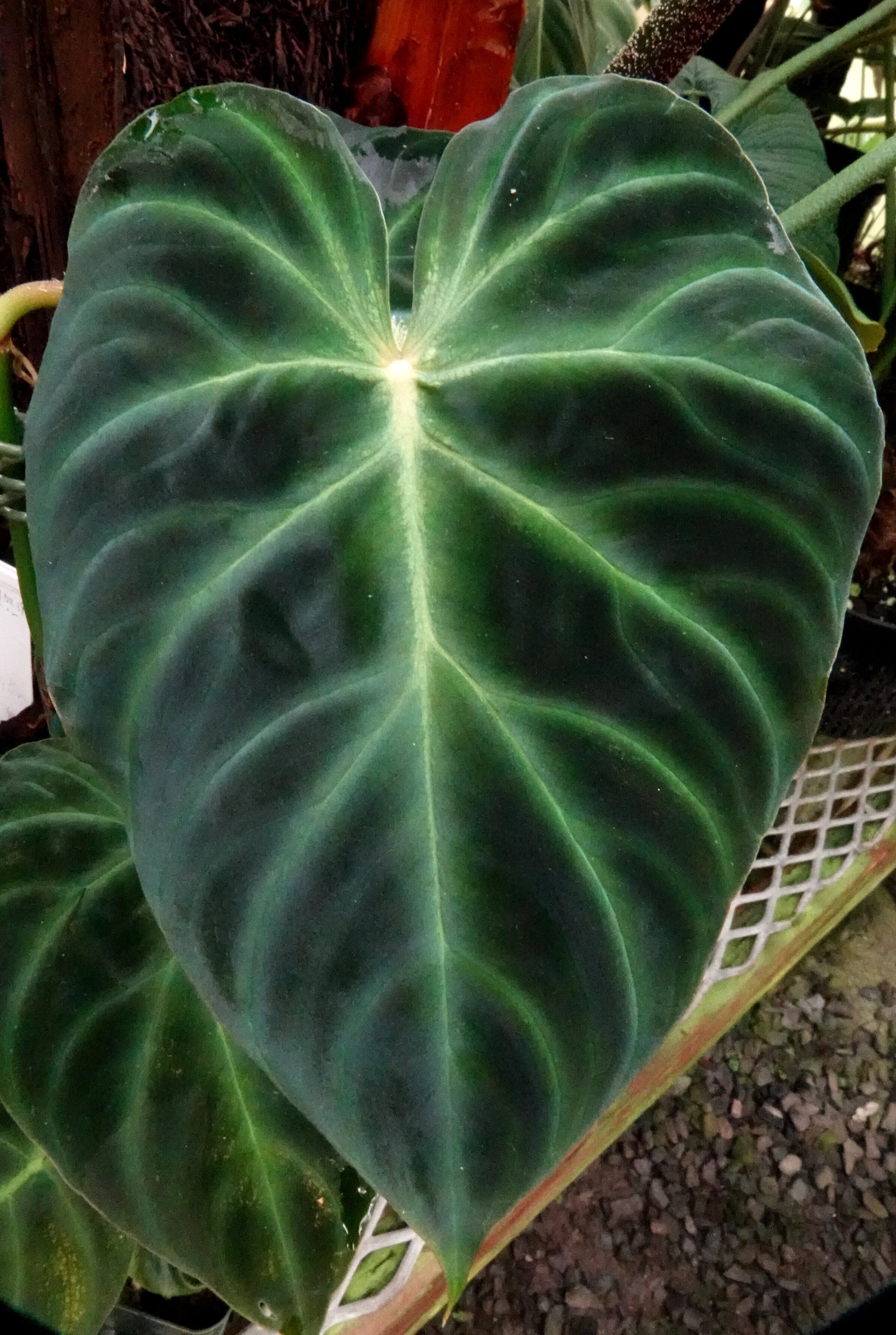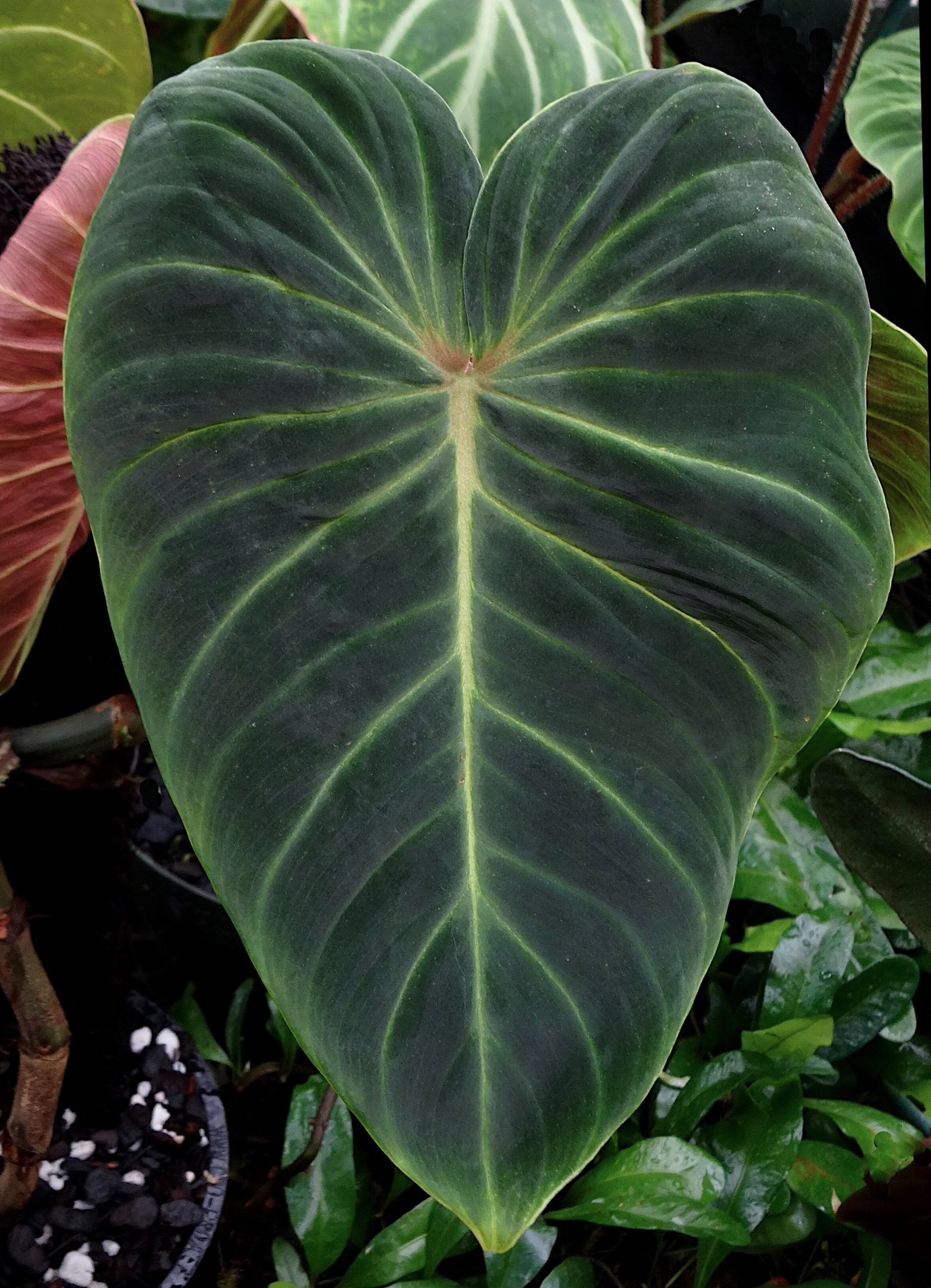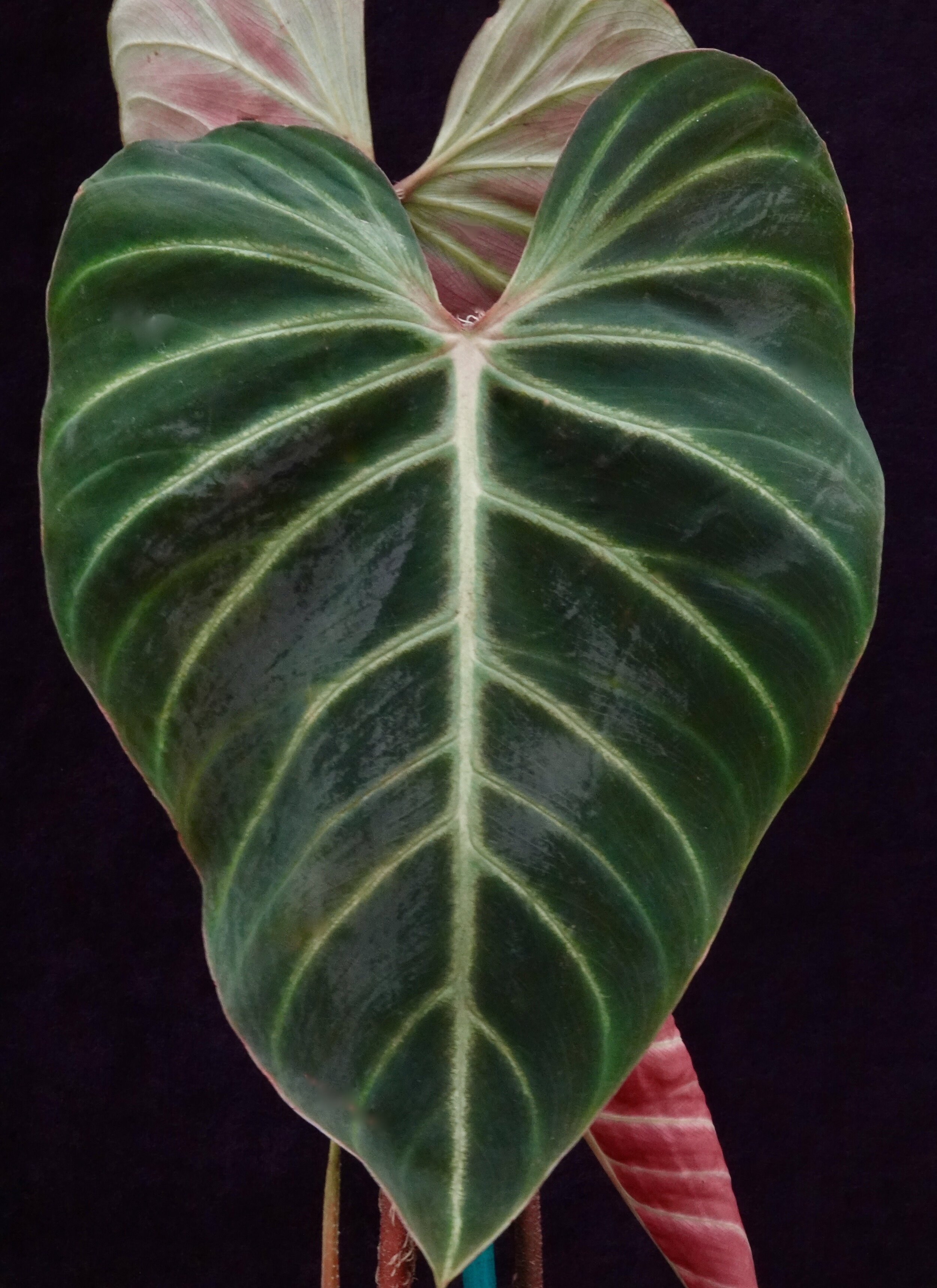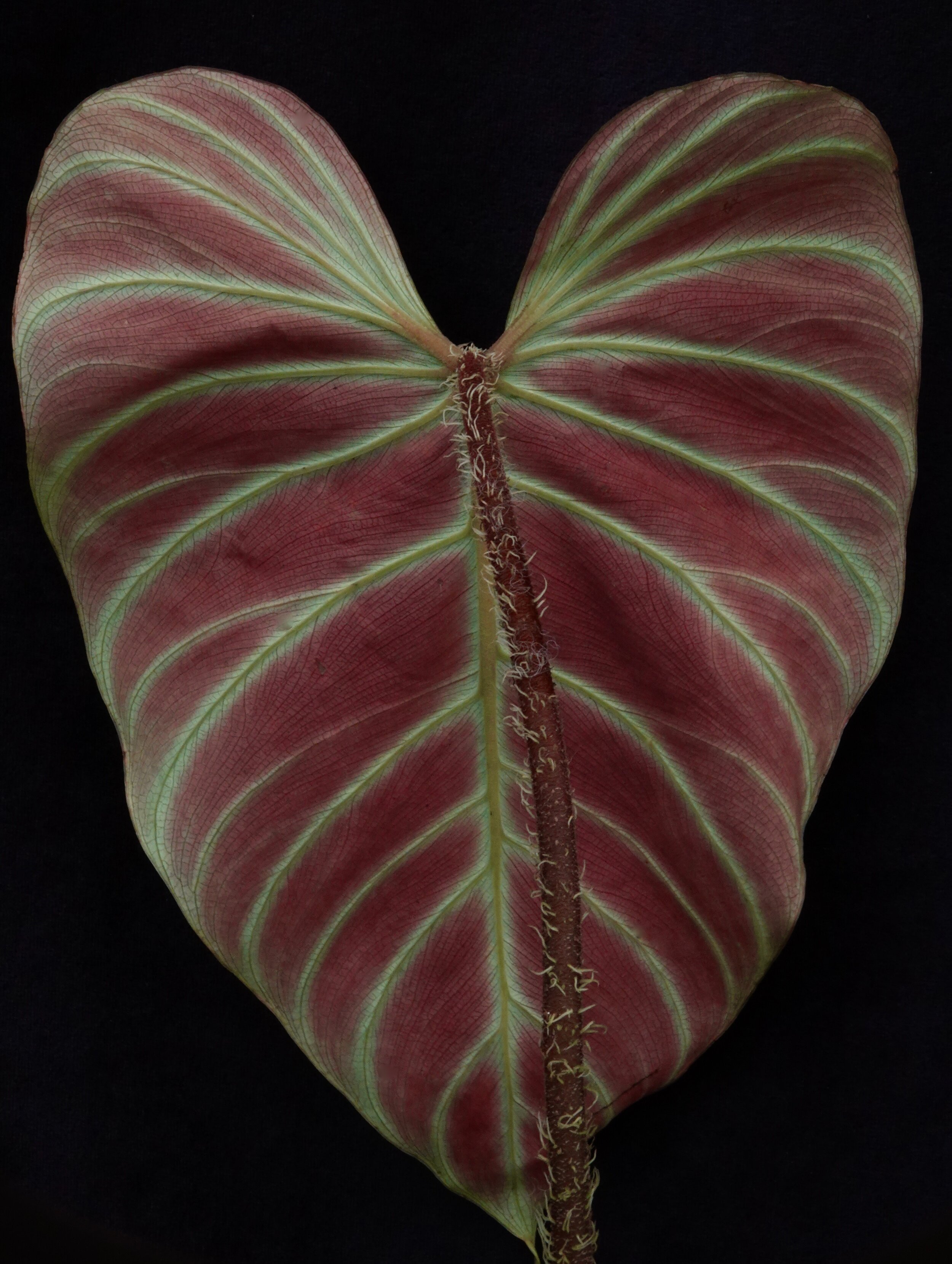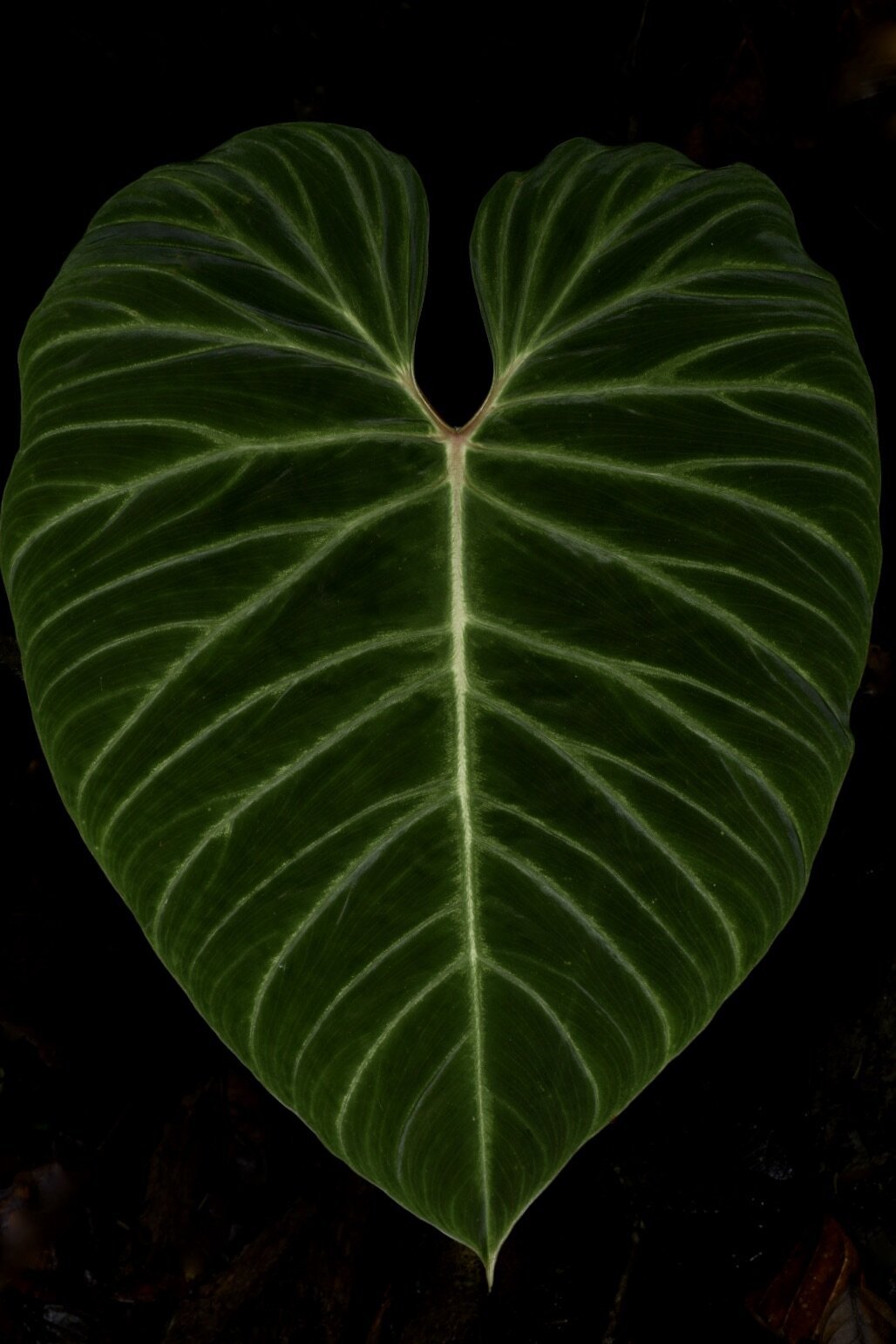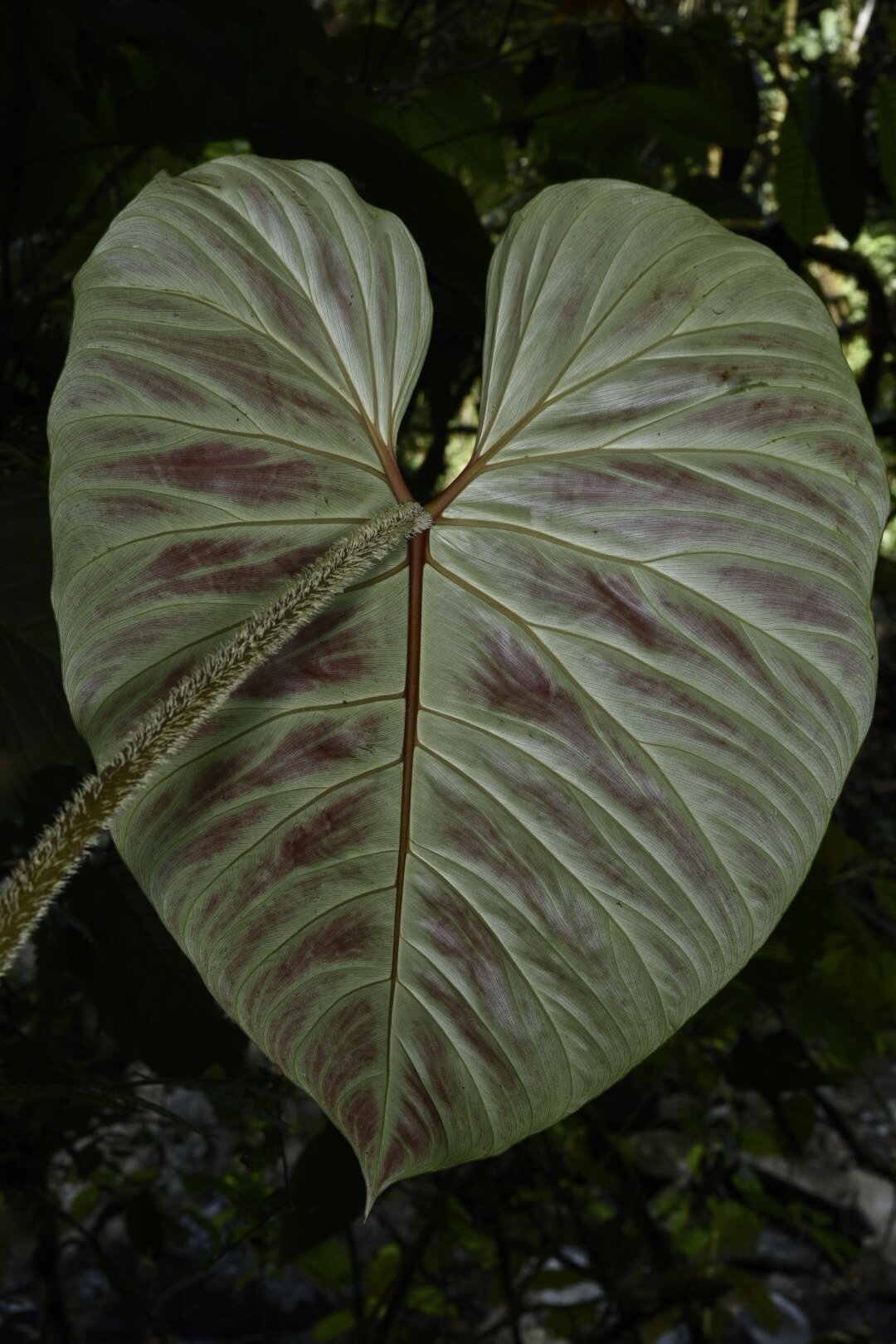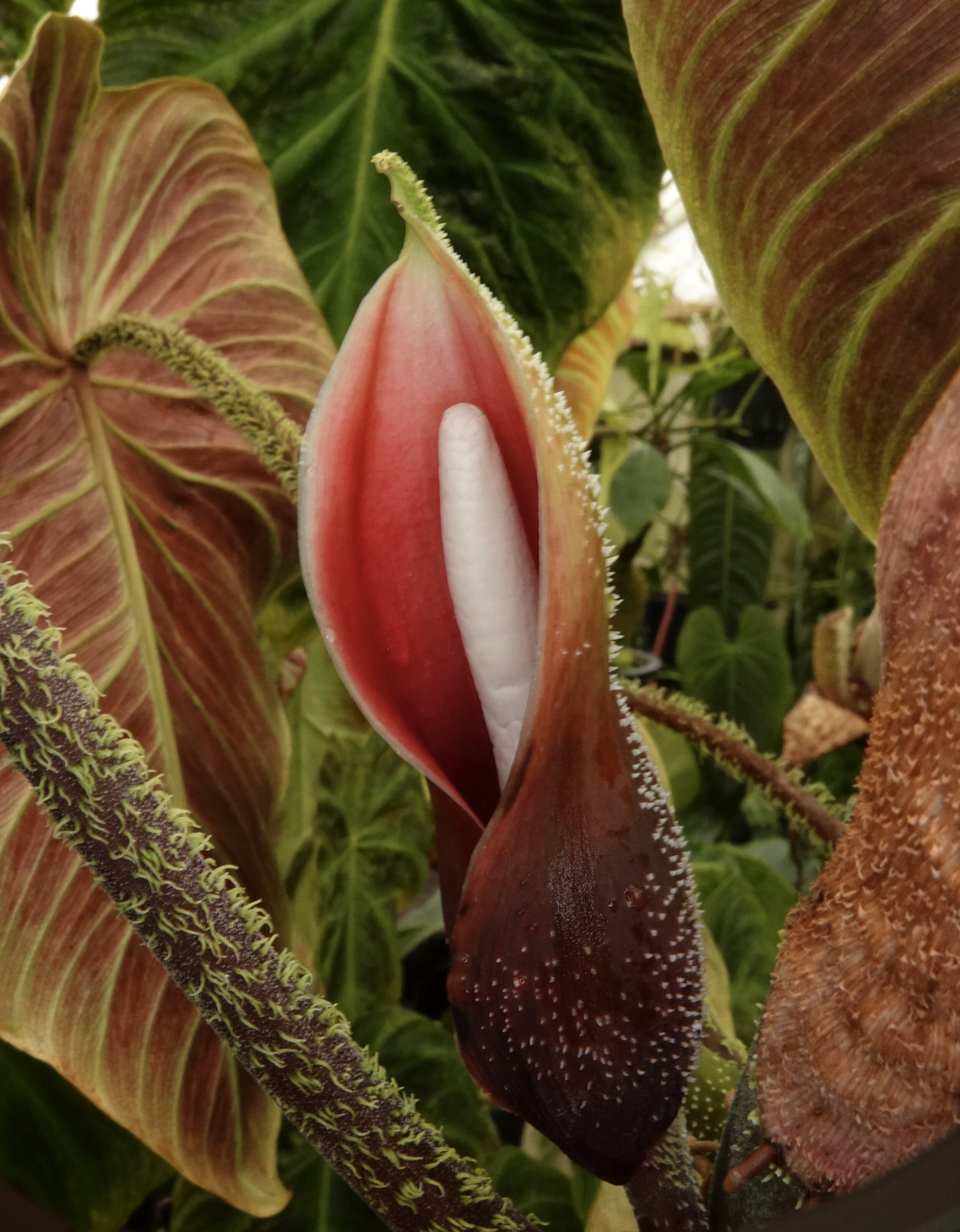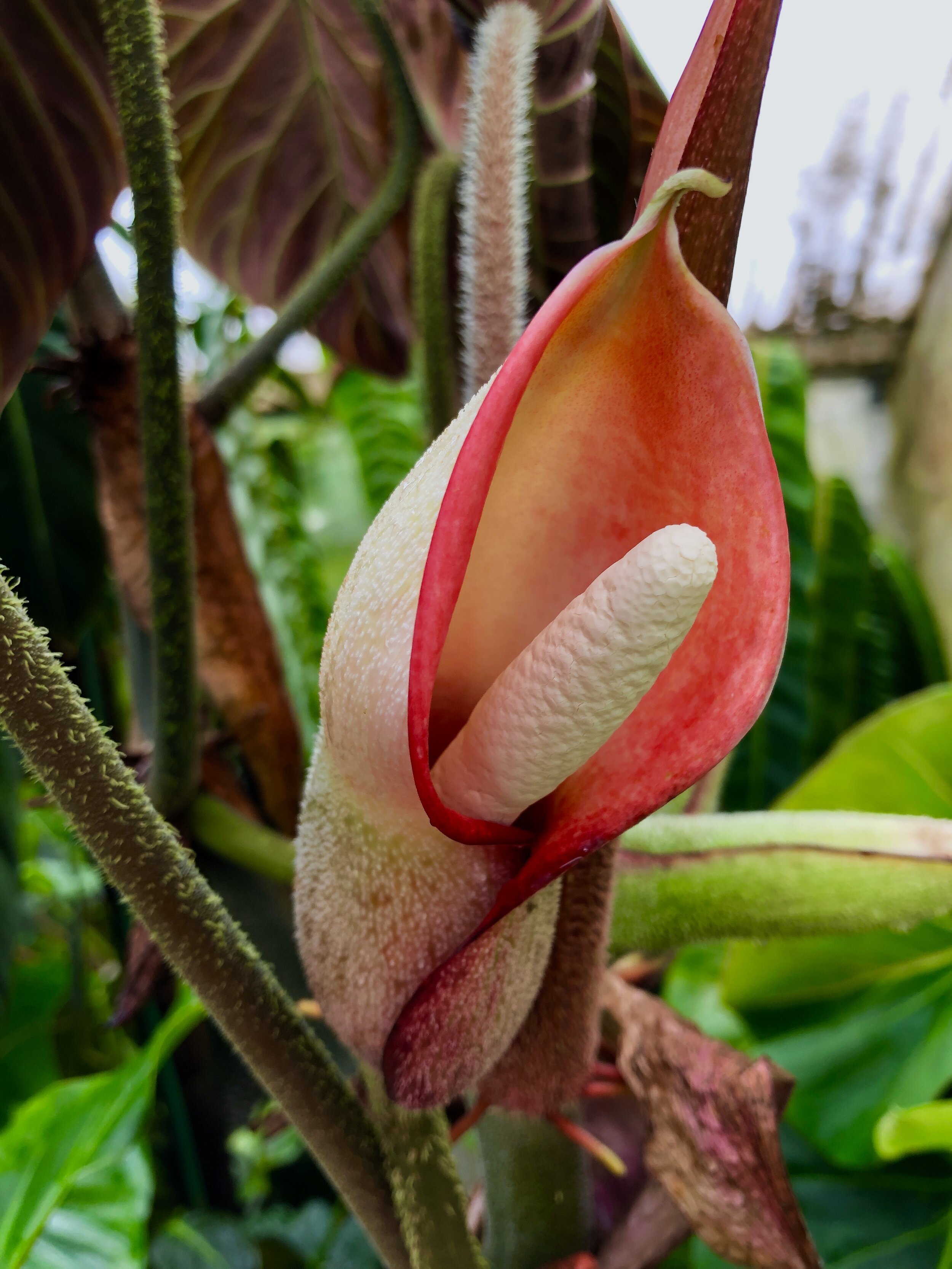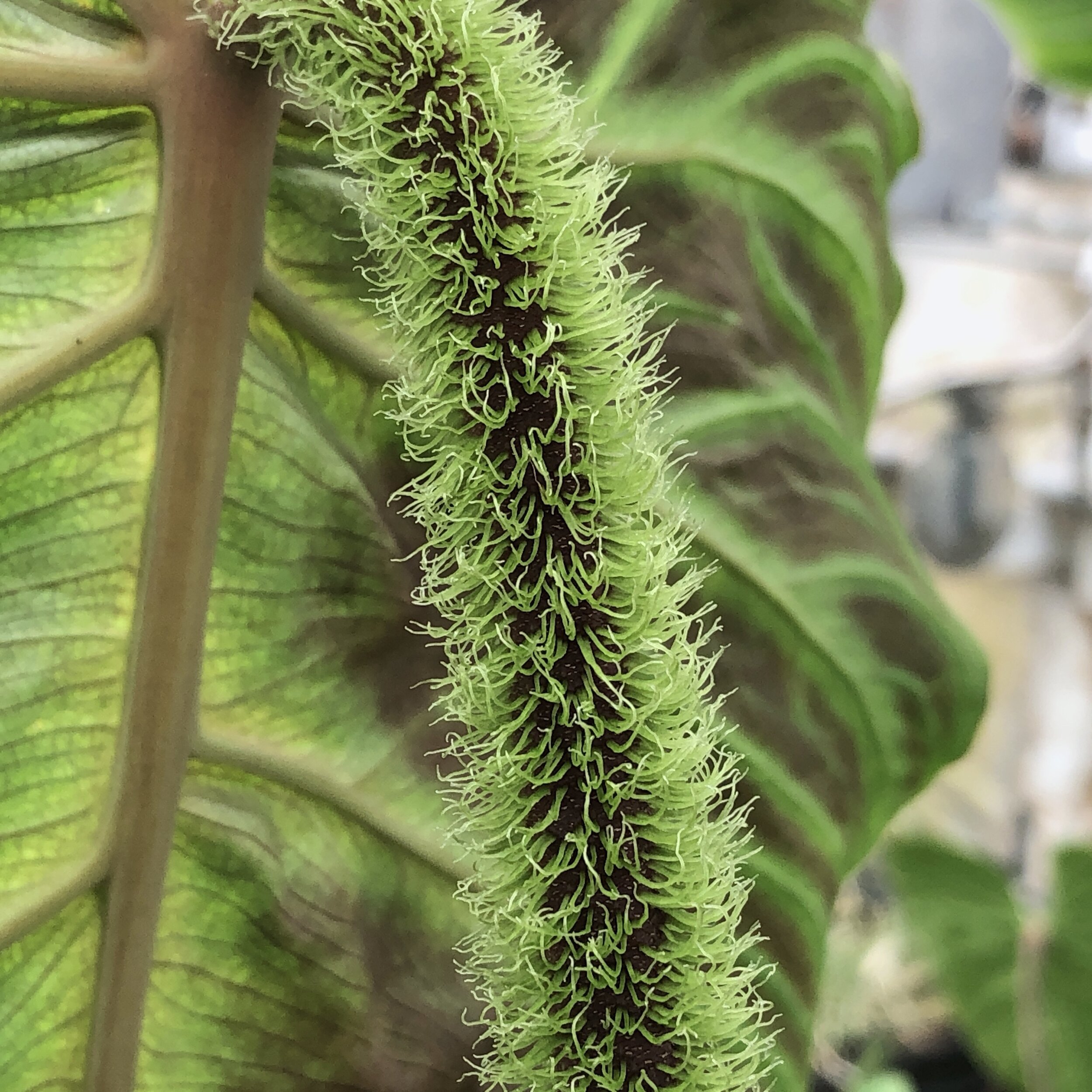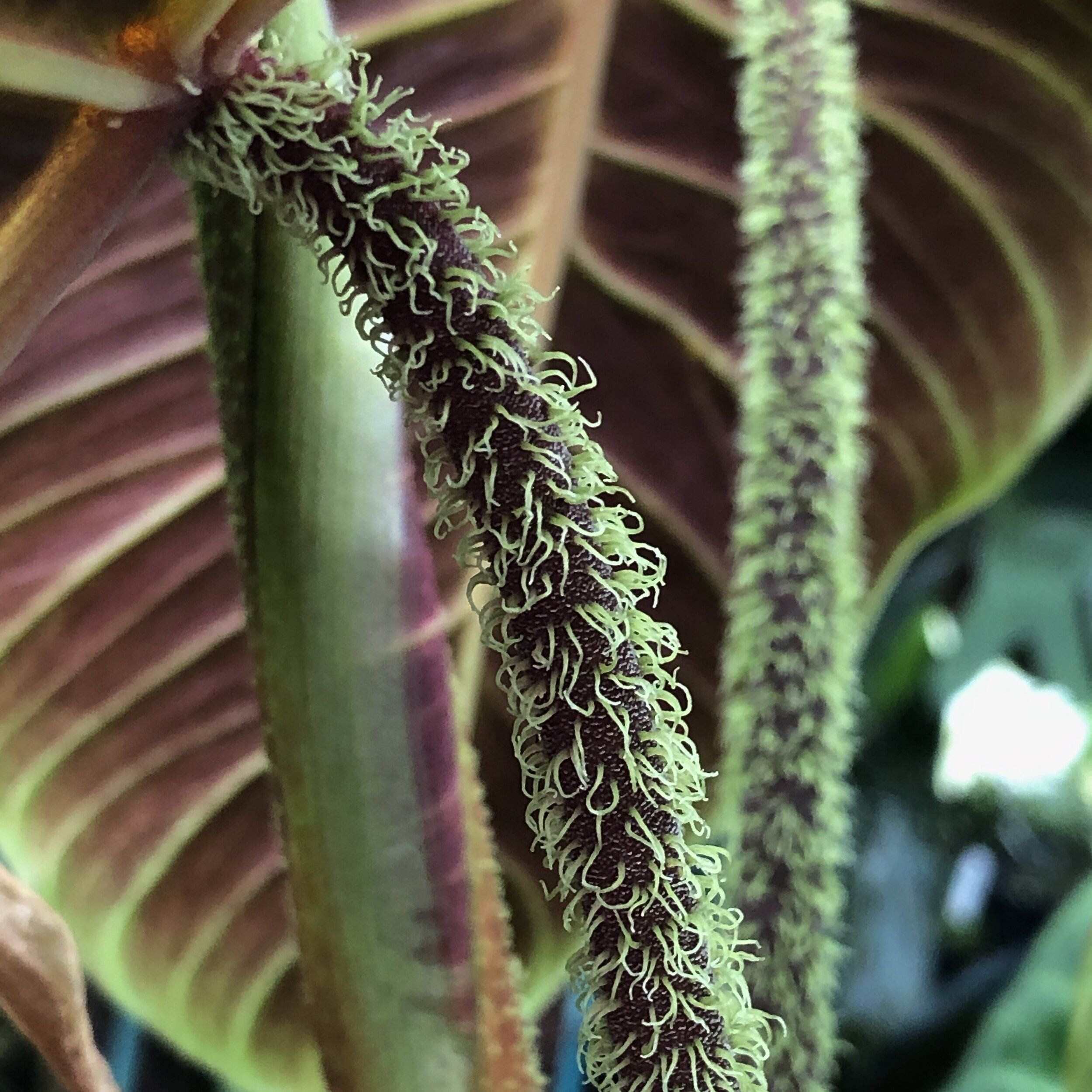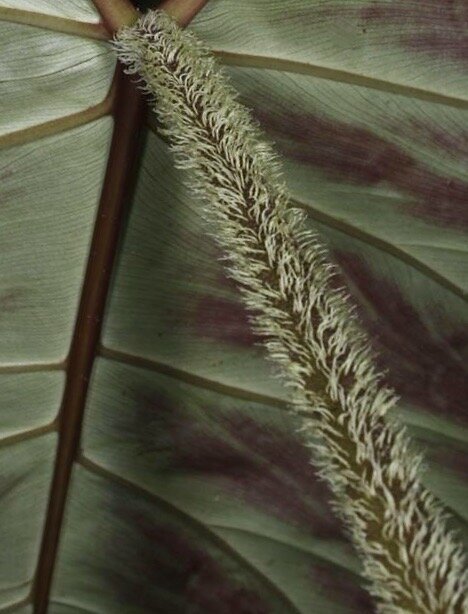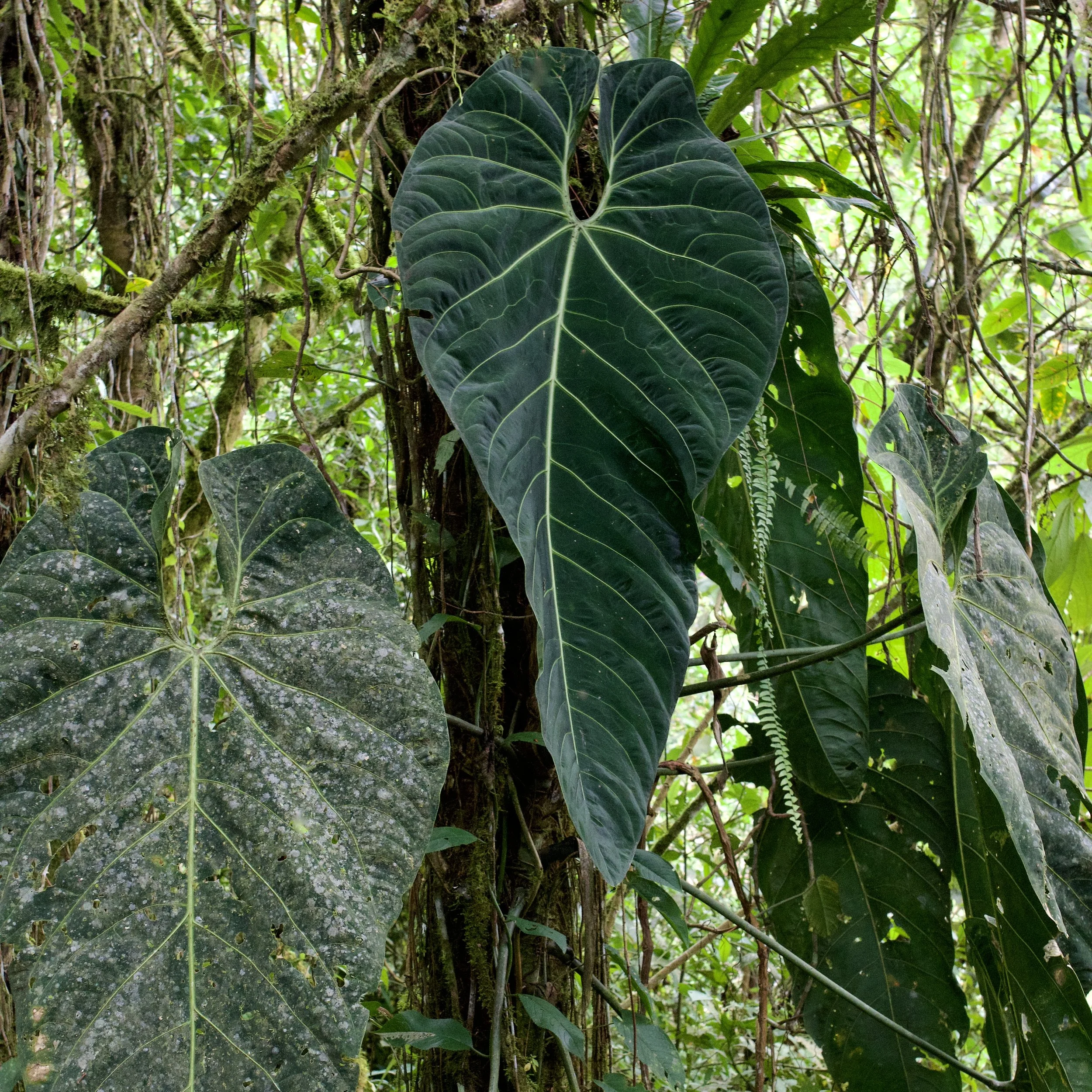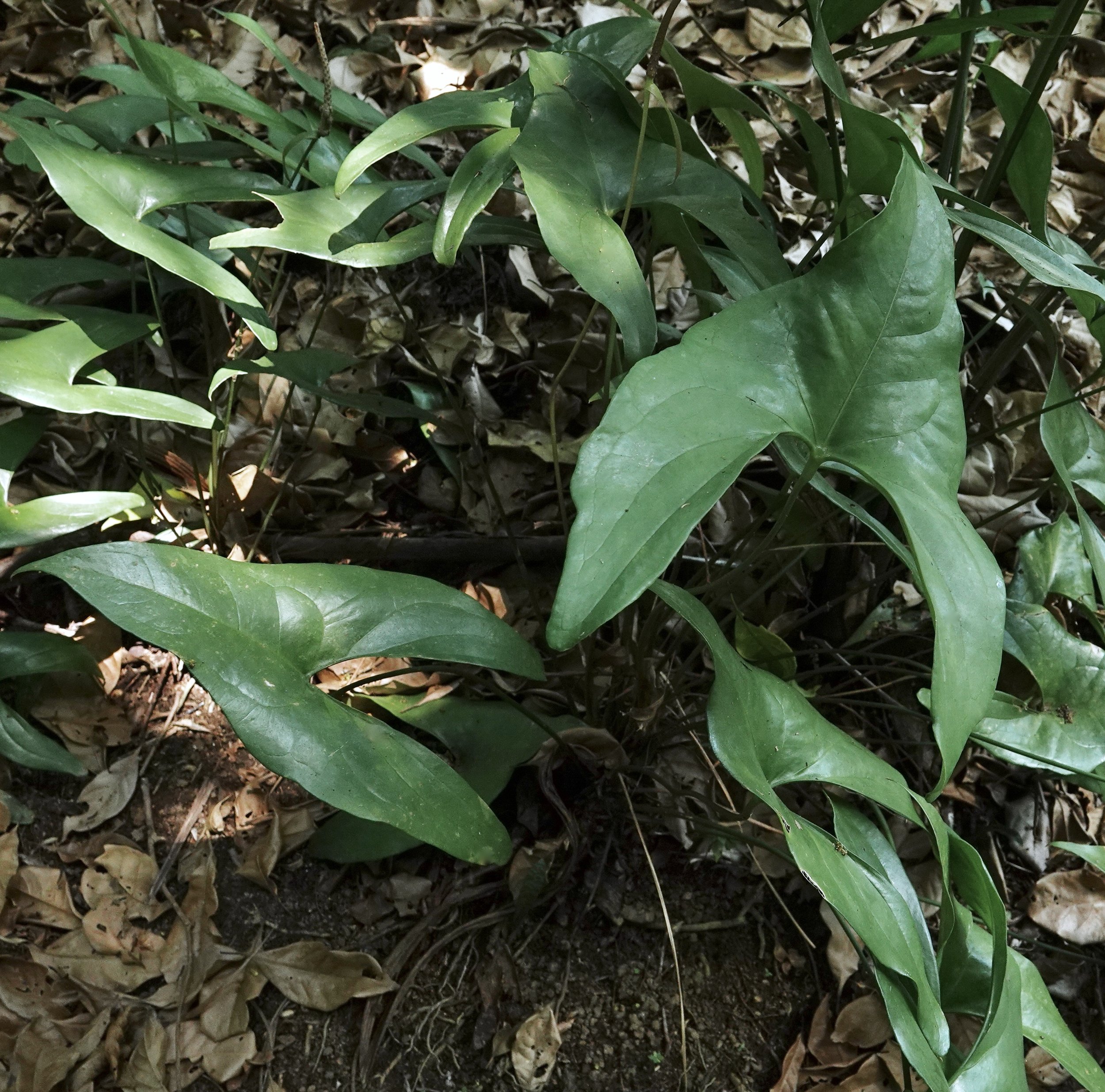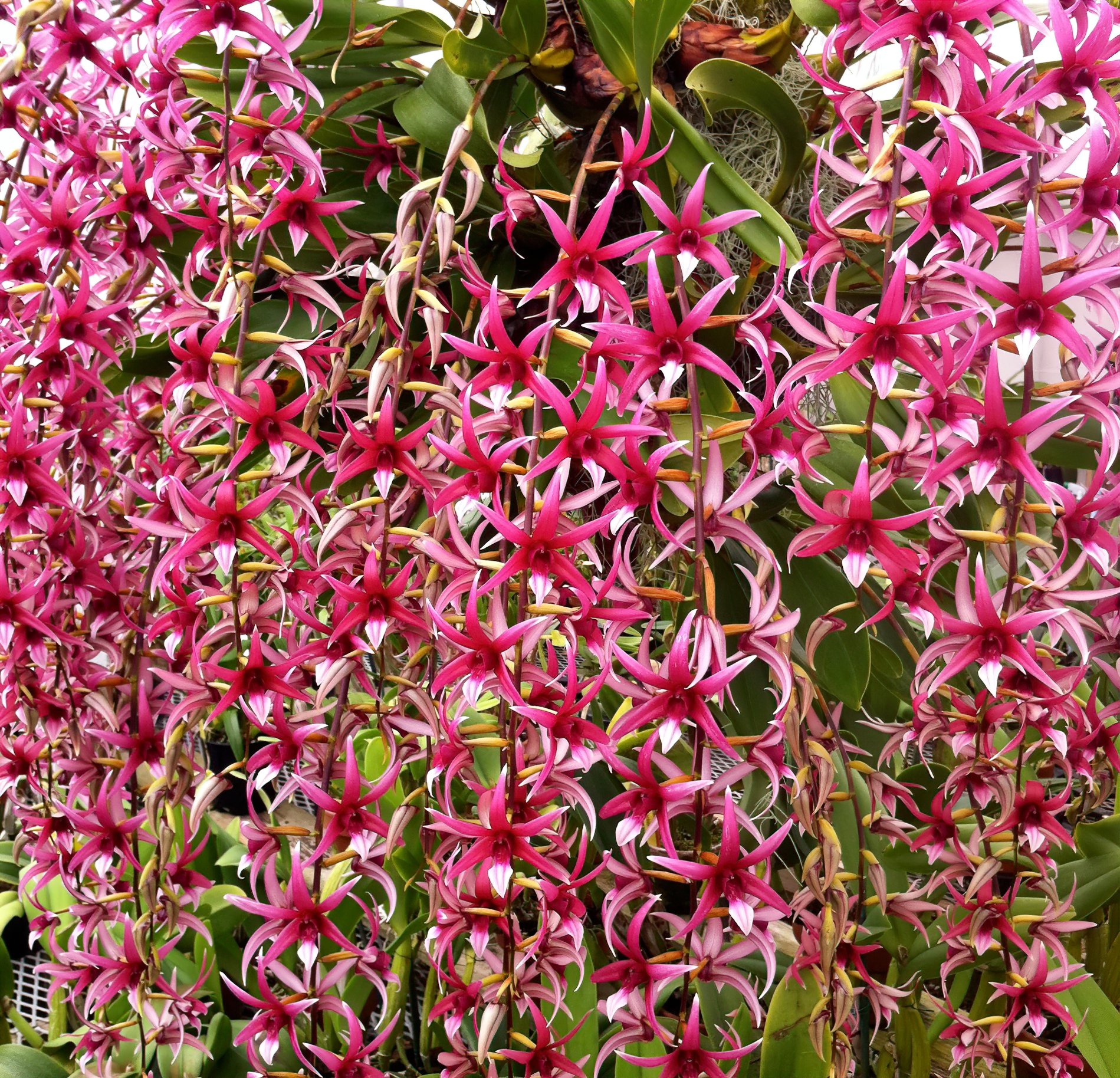The Philo Philes - Part I
SATIN & VELVET
by Jay Vannini
A large mature Philodendron verrucosum shown in nature as an adpressed hemiepiphyte in Caribbean versant foothill forest of western Panamá. This plant is growing just southeast of where the designated holotype of P. verrucosum was collected in 2008 (Santamaría 7453), so is representative of type locality material. Certain Costa Rican and Panamanian sites can harbor very imposing individual plants with exceptionally large and colorful leaves to ~30”/75 cm long. These exceptional ecotypes are scarce in cultivation outside of collections in their countries of origin. Notice the very bright red lower leaf surfaces visible center and lower left. Author’s image: ©J. Vannini 2020.
Philodendrons are extremely popular house, conservatory and garden plants throughout the world. They have been widely grown in northern Europe since the early 1800s and gained a global following over the next two centuries. In their countries of origin they are everywhere conspicuous features in homes, patios, gardens as well as in nature. The most commonly cultivated species, first introduced from the West Indies in 1793 (Birdsey, 1951) and now known as Philodendron hederaceum (Jacq.) Schott will tolerate a surprising amount of neglect and yet manage to cling to life in the most challenging of environments. This plant has also circulated in the houseplant and florists’ trade under various names including P. cordatum, P. micans, P. miduhoi, P. oxycardium and P. scandens. In contrast, many of the more desirable and costly species now popular in cultivation require climate controlled or near optimal environmental conditions to thrive in cultivation, not to mention more than just a soupçon of growing skill on the part of their owners.
Philodendron erubescens ‘Pink Princess’ grown by the author in a mixed tropical garden planting on a friend’s property in Guatemala. Author’s image.
Perhaps more than any other genus of plants, philodendrons have powered the astonishing wave of interest and enthusiasm among “rare” tropical foliage aficionados over the past few years. While eccentrically colored or variegated forms of common species (e.g. Philodendron erubescens ‘Pink Princess’) or rare hybrids (e.g. P.x joepii) tend to fetch the highest prices in the market, more discerning and experienced collectors - especially in the U.S. - have increasingly shifted their focus to rare Panamanian, Colombian, Ecuadoran, Peruvian and Brazilian Philodendron species with showy leaves and attractive plant forms.
Shown below, the undersides of young leaves of two high color forms of a pair of closely related Philodendron species still uncommon in cultivation. Left, a deeply saturated new leaf on P. squamicaule from western Panamanian cloud forest, shown in nature. Image: ©F. Muller 2020. Right, an atypical, very colorful new growth on a P. cf. serpens of unknown regional origin in cultivation. Author’s collection and image.
Leaf shapes and colors in philodendrons typically change, often dramatically, from seedling plant to maturity. Generally speaking, younger plants exhibit darker coloration, more pronounced velvety aspects (when this leaf character is present in the species) and simpler-form leaves with less complex vein patterns than they do at full size. With two exceptions among those species discussed here - P. melanochrysum and P. lupinum - fully mature leaves will have a much rounder aspect than juvenile or subadult plants seen offered for sale. Leaf, stem and spathe colors can vary considerably among different populations or individuals of the same species. This can sometimes be frustrating to botanists and naturalists trying to provide a name to a specimen of an unfamiliar variant. Exceptionally colorful philodendrons can be very valuable sources of germplasm for breeders. Propagators and collectors should always be on the lookout for particularly vividly colored plants that may prove of interest to ornamental horticulture.
Shown above, lower leaf, stem, root and inflorescence details of two outstanding, locality specific young mature Costa Rican Philodendron verrucosum nicknamed “Tico Blues” grown in the author’s collection and selected for breeding. Clones ‘Queen of Hearts’ on the left, and ‘Vampiro’ shown right. High color and contrast P. verrucosum selections from southern Central America may have the most colorful leaves of any naturally occuring aroids. Admittedly, some hybrid origin caladiums and aglaonemas will give them a run for their money foliage color-wise but lack size, colorful inflorescences and native panache. Large examples of this particular P. verrucosum type are a spectacle both in nature and cultivation.
Due to the fact that relatively few of these high end “It-plant” species have been propagated from seed or plant tissue culture in the past, aroiders and tropical gardeners in general continue to depend in varying degrees on direct wild source plants as well as indirect source stem propagates of wild-origin material made outside of their native ranges. Based on the numbers of recently sprouted, ancient, wrist-thick stems shown by foreign nurseries in promotional social media postings, commercial collecting pressure on at least a few species (e.g. Philodendron luxurians, P. lynnhannoniae, P. triumphans) is likely still very high.
Although many of the ornamental Philodendron species discussed here have been in cultivation since the mid and late 1800s, a surprising number of them remain poorly documented from nature. Species familiar to hardcore “Philophiles” and aspiring “Philodendron Phreaques” whose natural origins remain murky include P. luxurians, P. sodiroi and P. triumphans. Apart from these, further scrutiny of both cultivated and dried material may reveal two or more distinct and undescribed species currently labeled as P. furcatum, P. lupinum, P. lynnhannoniae and P. plowmanii.
It is now believed that only a third to one half of all existing Philodendron species have, (a) been validly described and published, (b) have herbarium vouchers and diagnostic descriptions being prepared for publication in a botanical journal, or (c) have been collected and identified as novel by an aroid specialist but are still sitting way down on the list of someone’s priorities (Croat, pers. comm.; pers. obs.). Because of this, it is highly probable that many new and desirable velutinous or satin-leaf forms of interest to ornamental horticulture will come to light over the next decade (F. Muller, pers. comm., pers. obs.).
Stay tuned.
A mature Philodendron grandipes shown in nature in eastern Panamá. Although admittedly variable across its range, some (most?) plants currently being sold online under this name are misidentified. Author’s image.
While my personal collection of uncommon or rare philodendrons is relatively modest by some large public garden standards (~50 species, ~60 forms overall including distinctive ecotypes), I currently grow or have grown in the recent past all of the plants discussed below. I am also familiar with many of them in their natural haunts as well as in other collections of floral exotica, both public and private.
This list does not pretend to be exhaustive and there are many recently described and at least a couple unpublished species I am aware of that would fit in well here. Unfortunately, most are either not cultivated outside of origin or else are extremely rare in cultivation and not commercially available at this time.
Author names follow currently accepted species names. Please be aware that some familiar binomials used in ornamental horticulture remain unpublished; these are followed by author name and the notation “ined./ms. in prep.” = unpublished species/manuscript in preparation or “in press” = publication expected very soon. Throughout the text, different botanists’ names and collection numbers are cited for corroborative and reference purposes. All of these may be verified through the Tropicos online database.
The Species
Philodendron corrugatum Croat ined./ms. in prep.
Alternate trade names: Commonly mistaken by export nurseries for a variety of somewhat similar-looking Philodendron and even Anthurium (!!) species from Colombia and Ecuador. Juvenile plants are especially easy to confuse with other similar-looking philodendrons and their appearance can change substantially as they grow out.
Hybrids: None
Leaf detail on beautifully-grown mature example of Philodendron corrugatum ined. (as “P. corrugosum”)at the Huntington BG. Image courtesy of: ©D. Hannon 2020.
A fairly showy terrestrial and short hemiepiphytic species occurring from 1,300-6,500’/400 to 2,000 masl in western Colombia. One of the larger species of this fine ribbed-leaf group with creeping habit that has made it to cultivation, with leaves to at least 24”/60 cm. Because of its very delicate leaves, it requires fairly benign conditions to survive in captivity.
Not suitable as a houseplant and requires, shady, intermediate conditions and uniformly high humidity to thrive. My experience with this species is limited, but undoubtedly it is as mite susceptible under warm, dry conditions as its close relatives.
Philodendron fibrosum Sodiro ex Croat
Alternate trade names: In the past this species has been confused with Philodendron verrucosum by more than one experienced botanist. Some online sales offering P. verrucosum that show juvenile P. fibrosum in associated images indicate this mistake still occurs.
Hybrids: None.
While more a big shiny green curiosity than a beauty, this southwestern Colombian and northern Ecuadoran native is nonetheless a very handsome plant when well grown. Terrestrial to short-hemiepiphytic when mature. Despite most reports originating from middle to high elevation cloud forest ecosystems (4,200 to 8,000’/1,300-2,450 masl), the ease with which cultivated plants grow in warm greenhouses suggests that at least some are being sourced at the lower elevational limits of this species between 2,400 and 3,250’/750 and 1,000 masl.
The most attractive features of these plants are their large (to 24”/60 cm) heavily pleated, subglossy to (barely) subvelvety and near orbicular leaves with very densely scaled petioles that appear almost shaggy when viewed up close. The inflorescences strongly resemble those of Ecuadoran Philodendron verrucosum. Like that species, some individuals display attractive light pink or reddish-tinged lower leaf surfaces when young and cultivated in deep shade. The plant’s stem is prone to wander around in circles a bit, so training is required to maintain a desirable upright aspect.
Above left, a mature leaf on a Philodendron fibrosum growing in the author’s collection. Shown right, petiole detail of the same individual showing the densely arranged, hair-like scales. Some P. fibrosum clones have a subvelvety upper leaf surfaces that differ slightly from the aspect of the plant shown here. Compare mature leaf aspect with that of P. triumphans shown below.
Philodendron fibrosum was named by Jesuit botanist Luis Sodiro from material collected in the vicinity of Quito, Ecuador in the early 1900s. However, like all of his philodendron discoveries, it lacked a formal description and remained ined. for more than a century. Thomas Croat provided one in 2010 and clarified its very close and sometime confusing affinities with P. verrucosum.
Mite resistant, but very sensitive to root drying which will reliably brown tip the very soft-textured leaves.
Philodendron furcatum Croat & Bay
A group of young, seed-grown Philodendron furcatum growing in the author’s collection. Author’s image.
Alternate trade names: Often confused with Philodendron lynnhannoniae by nurseries and hobbyists alike.
Hybrids: None
This species (and lookalikes) is native to coastal and foothill rainforests from near sea level to ~4,900’/1,500 masl in western Colombia ranging just into extreme northwestern Ecuador.
A very beautiful and compact terrestrial species with soft, glittering green leaves that exhibit strong iridescence when grown well under very shady conditions (~250 fc). Somewhat heat intolerant (even briefly), especially those originating from cloud forests, this plant has proven consistently challenging to Florida growers (E. Offolter, pers. comm.). As is the case with some Philodendron lynnhannoniae accessions, I have found that it will reliably and rapidly brown tip and/or defoliate if exposed to temperatures above 90 degrees F/32 C for more than a few days.
This is one of the few delicate terrestrial Philodendron species that has been artificially propagated and grown from seed. Comments made to me by several US growers suggest these plants are noticeably easier to succeed with than imports that come in under this name that actually match the species description.
Young mature Philodendron furcatum looking a wee bit singed around the edges as it recovers from a summer heat wave. Author’s plant and image.
Extremely susceptible to mite infestations and leaf loss if kept hot and dry.
Not suitable as a houseplant although - because of its relatively small size - Philodendron furcatum will thrive in a large climate-controlled terrarium or Wardian case.
Philodendron gigas Croat
Alternate trade names: None
Hybrids: I know of several attempts to hybridize this plant in different countries but no apparent successes thus far.
A large flowering Philodendron gigas growing exposed on the upper trunk of a canopy tree at the type locality in Caribbean foothill rainforest of central Panamá. Author’s image.
An imposing, highly ornamental eastern Panamanian species discovered by Thomas Croat and Guanghua Zhu in July 1994, this plant attains massive dimensions in the upper canopy of emergent trees in lowland Caribbean versant rainforest of Panamá Province and Guna Yala Comarca. Because of its enormous mature leaf size (>48”/1.25 m), it is not a particularly good subject for cultivation outside of sheltered, fully tropical gardens where it will need a sizeable tree or untreated 20-30’/6.15-9.25 m pole to climb up and wrap around. Even in large, humid conservatories most of these plants tend to stall out at 24”/60 cm leaf sizes and do not look remotely like the >80’/24.5 m tall specimens I have seen in nature. I first observed this species in Guna Yala in 2000 and have since found it both at the type locality and in adjacent forested areas, all between 900 and 1,100’/280 and 330 masl. The stems on fully mature, canopy dwelling plants are remarkable and resemble bundles of hawsers snaking up the tree. Battered windfalls may occasionally be encountered amid storm-felled branches or at the edge of recently deforested plots that patchwork the area.
Above left, a fallen branch on a landslip colonized by subadult Philodendron gigas making the best of a bad situation while exposed to full sunshine near the type locality in Panamá. Author’s image. Left, a large wild seedling plant shown growing on the forest floor at a location close by. Image: ©F. Muller 2020.
With its soft, subvelvety, closet door-sized leaves this species is an absolutely magnificent spectacle in climax lowland rainforest and when well grown in captivity but takes up a huge amount of vertical space at mature size due to its ultimate height and leaf dimensions. It requires uniformly high humidity, reasonably good water quality and fairly low light levels to thrive when young. Despite its allure and relative ease of culture, because of its growth habit it is not really recommended for novice growers interested in satisfaction beyond online bragging rights. Very young plants may be reminiscent of seedling Philodendron melanochrysum as well as some juvenile P. hederaceum forms but exhibit a more velvety aspect with a more conspicuous central vein.
Shown above, a large Philodendron gigas flowering in a tropical garden setting together with inflorescence detail. Images: ©C. Hall & A. Dearden 2020.
This species can thrive as a houseplant on a totem when small, but is a bit more challenging as an interior plant when larger.
Fairly mite resistant.
Philodendron glanduliferum Matuda
Alternate trade names: When fully mature, its remarkable resemblance to the Peruvian endemic Philodendron lynamii Croat ined. has led to it recently being called the “Mexican lynamii” online. Several plants shown on the internet and identified as orphaned accessions of Philodendron devansayeanum Linden in the EU also possess strikingly similar leaf and petiole characters. It is not unlikely that some of these captive plants are actually descendants of P. glanduliferum accessions made in southeastern México by European visitors during the plant collection tourism heydays of the 1970s and 1980s.
Hybrids: None.
A mature Philodendron aff. glanduliferum shown growing as a terrestrial in a foothill rainforest of northern Central America. Image: ©F. Muller 2020.
This Philodendron species is notable for having disjunct populations in Oaxaca, Tabasco and Chiapas states, México as well as the Caribbean foothill forests of northern Central America from 1,600-6,500’/500 to 2000 m. Thomas Croat published P. glanduliferum ssp. camiloanum in 1986 based on a Julian Steyermark collection (101804) from the lowlands of southwestern Venezuela. It was distinguished from the nominate subspecies of P. glanduliferum in having trichomes/hairs along the entire length of the petiole and overlapping basal lobes on the leaves. This taxon is now known to occur from lowland rainforest into middle elevation cloud forest to ~4,200’/1,300 masl in both Apure and Táchira States. Given the huge distance between populations as well as their morphological differences, the Venezuelan plants likely warrant full species status (edit: Following this article’s publication, Tom Croat confirms P. camiloanum is indeed a different species and will be published as such in 2021.)
Newly opened inflorescences on cultivated Philodendron lynamii Croat in my collection. These showy plants from northwestern Perú are visually similar to the somewhat enigmatic P. devansayeanum L. Linden but in flower the spathes in P. devansayeanum are red on both surfaces. Image: ©Jay Vannini 2024.
An interesting and relevant footnote that speaks to the visual similarity of Philodendron lynamii Croat ined., from San Martín Province in Perú and this species: A 1981 Plowman collection (11640E) of a hemiepiphytic Philodendron from 3,000’/925 masl in Mariscal Cáceres Province, Perú was tentatively assigned to P. glanduliferum by Thomas Croat in 1982. This preliminary, placeholder identification is a reflection of the relative lack of knowledge of regional philodendron distribution and diversity four decades ago, but nonetheless evidences the great superficial similarity between P. glanduliferum and two Peruvian philodendrons that are not closely related to it.
Above left, new leaf on a northern Central American Philodendron aff. glanduliferum showing the very attractive rose and coral colors evident on emergence. Right, a mature leaf with an open leaf sinus, the characteristic reddish-purple geniculum and striate upper petiole. Images ©F. Muller 2020.
While juvenile leaves display both a satiny aspect and pink to pale violet undersides, mature leaves (to ~24”/60 cm) are generally subglossy; inclusion of Philodendron glanduliferum here is admittedly a bit of a stretch. This attractive but poorly known philodendron undergoes a series of color and morphological changes as it matures, including the gradual loss of the elongated petiole scales especially evident on the genicula of younger examples. Most plants also undergo a rather unusual change of lifestyle as they mature. Starting off life as short climbers, at least some become decumbent in adolescence then, later still, flowering mostly as creeping or clustering terrestrials on leaf litter or rocks in shady forest understory. Grown with vertical support in cultivation they will grow and flower happily as hemiepiphytes. Although older references indicate that it is strictly terrestrial and somewhat unique in this aspect the region, both Mexican and Central American collections assigned to this taxon have included both terrestrial and hemiepiphytic individuals of all size classes. As illustrated below with some well-cultivated P. gloriosum in Guatemala and P. cf. plowmanii in Perú, in my experience almost all the “obligately prostrate” terrestrial philodendrons will clamber up trunks and other vertical surfaces to respectable heights when faced with an obstacle.
The large and colorful inflorescence of a northern Central American Philodendron glanduliferum in nature. Image: ©F. Muller.
Shown above, juvenile Philodendron glanduliferum from both Oaxacan (left) and northern Central American (right) populations growing in the author’s collections in Guatemala and California. Plants are still in the juvenile climbing stage. Note the conspicuous “tuft” of elongated scales on the genicula of both plants that extends lower onto the upper petiole as large subadults but are lost at full maturity. Author’s images.
Still very rare in exotic plant collections. Its ease of cultivation, very attractive new leaf color and form, together with its great visual similarity to Philodendron lynamii ined. now in horticulture should make this a popular collector’s item as more of the very limited cultivated material is propagated and distributed. Spathe colors can be both attractive and rather variable within the northern Central American populations. Some share brilliant red spathe exteriors with cultivated P. lynamii ined. (e.g. Förther s.n. 1989), while others have vivid white striping over carmine-flushed floral chambers (see image shown right).
Lowland and foothill forest origin plants appear very temperature tolerant. The few plants I have personal experience with have proven fairly resistant to mite infestations in cultivation.
Philodendron gloriosum André
Alternate trade names: None
Hybrids: Philodendron gloriosum x P. melanochrysum (P. Glorious - Henderson), P. giganteum x gloriosum (still unnamed - Hall & Dearden), P. gloriosum x P. pastazanum (P. Dean McDowell - Banta), P. gloriosum x P. McColley’s Finale (Garner).
Philodendron gloriosum propagated by the author growing as a groundcover in a tropical garden setting in Guatemala. Author’s image.
A young Philodendron BGB (giganteum x gloriosum - Hall & Dearden) in a 6”/15 cm pot in the author’s collection. This new clumping Australian hybrid shows great promise even when small. Assuming an ultimate size and color somewhere between its parents, these plants will likely produce ~40”/100 cm length blue-green and white-veined leaves when mature. 14 month-old seed-grown plants in my collection have have already produced 16”/40 cm leaves. Author’s image.
A very handsome terrestrial species with large, subvelvety, bluish gray leaves with chalk white contrast veining. Discovered in 1876 by Édouard André near the middle Río Guatiquia in what is now Cundinamarca Department, Colombia. Plants matching cultivated material have been reliably reported from a few localities in central Colombia between 1,600 and 1,950’/500 and 600 m. A lobby mass-planting of quite distinctive-looking terrestrial philodendrons that strongly resembled this species was observed by me in a hotel garden in Iquitos, Perú in 2001. They were said by staff to have originated from locally collected material several years earlier. While by no means impossible, I have reservations about that claim. This species is popular and widely cultivated in public gardens and private collections throughout the Neotropics (pers. obs.) and is often thought to be an indigenous plant by local gardeners and nursery owners in countries it is not native to.
Showy, glaucous blue and satin-surfaced leaves on a group of large Philodendron gloriosum growing as a short hemiepiphyte in a garden setting in Guatemala. Like many other terrestrial philodendrons, P. gloriosum will readily “walk” up tree trunks or over low obstacles when given the chance. Image: ©P. Rockstroh 2020.
Philodendron gloriosum is generally easy to grow and can excel as a houseplant if sited carefully and kept reasonably humid. Because of its large mature size, this plant is at its best when grown as a tropical garden or warm greenhouse subject. One of the most attractive knee-high tropical groundcovers of all and looks especially good when mass-planted around the base of a large tree or against any attractive wall.
Slightly mite susceptible when kept warm and dry.
Philodendron vanninii ined. A mature leaf on the live type specimen in the author’s collection. This plant’s relationships with P. lupinum remain unclear. Author’s image.
Philodendron lupinum Gonçalves & Carvalho
Alternate trade names: None, but quite dissimilar although sagittate leaf plants masquerading as this species are commonly seen for sale online. In limited numbers and originally propagated from two clones, this species circulated for a number of years among aroid collectors from the living type plant of Philodendron vanninii Croat ined. that I exported from Guatemala to a U.S. nursery in 2005 as well as an orphaned accession propagated by an aroid grower in Hawaii. Both clones are of Peruvian Amazon origin. Following the Gonçalves and Carvalho publication of P. lupinum in 2008, these two clones were assumed by all – including me - to represent that species, and have traded in ornamental horticulture as such for the past decade. See below for my current perspective on the status of these populations after a recent reread of the Gonçalves and Carvalho paper with a living plant in hand.
Hybrids: None. I have attempted a couple “stretch” crosses in California, but no success so far.
As Philodendron vanninii Croat ined., first collected at the ExplorNapo Lodge at Sucusari, Maynas Province, Perú and in Amacayacu NP above Leticia, Amazonas Department, Colombia in 1991 by John Pipoly III during a regional floral survey. Apparently overlooked for the next decade, I found several plants growing in nature near Nauta, Maynas Province, Perú in early 2001 (cultivated material vouchered as Croat 84925 and Croat 90206). Philodendron lupinum proper was first discovered as a live plant of unknown geographic provenance in the Roberto Burle-Marx collection at Rio de Janeiro, Brazil, also in early 2001. Gonçalves et al. later discovered it growing in nature in low elevation Terra Firme forest as a hemiepiphyte in Acre State, Brazil in August 2001. Several months after this the same species was collected by Thomas Croat at a nearby Brazilian locality (Croat 85581).
This is an adpressed-hemiephytic, very striking Upper Amazonian rainforest Philodendron species known from a handful of localities in the tri-border area. The specific epithet refers to the very distinctive wolf’s head shape of mature leaves.
Despite similar material being fairly well-known and documented by both live plants cultivated in south Florida, Hawaii and Guatemala as well as herbarium vouchers from Amazonian Perú by the early 2000s, Philodendron lupinum was described as a northwestern Brazilian narrow endemic from Cruzeiro do Sul, Acre State, ~300 mi/480 km south of the Amazonian Perú localities.
Juvenile leaves of Philodendron vannini ined./P. lupinum in the author’s collection. Subadult leaves grown under shady conditions have very attractive pink or pale violet lower (abaxial) surfaces. The subvelvety aspect of these leaves is also evident in this photograph. Author’s image.
The diagnosis of Philodendron lupinum Gonçalves & Carvalho, is based on a single wild collection from Cruzeiro do Sol, Acre State (Gonçalves et al. 952) and observations of a cultivated plant of unknown origin held in Brazil. It differs in several aspects from the Peruvian Amazon plants now in broad cultivation outside of Brazil. While the leaf details in the accompanying black and white illustration are very similar, inflorescence color and morphology as well as live leaf details differ substantially from the plants collected in the vicinity of Iquitos, Perú about 20-30 years ago. Complicating the matter further is that the black and white photograph that the authors include in their published description, showing a stem propagation of the live type plant under cultivation at the Universidad Católica de Brasilia’s Horto Botanico, does not match any of the Peruvian plants being cultivated around the world today as P. lupinum or P. cf. lupinum.
Philodendron vannini ined./P. lupinum shown growing as a hemipiphyte in nature in Amazonian Perú. Note the very dark upper leaf aspect and violet underleaf surfaces. Image: ©W. Lamar 2020 scanned from a print film snapshot.
At this time, Tropicos maintains an open listing of Philodendron vanninii Croat ined. with both Pipoly and Croat accessions listed as specimens. The Plant List currently places P. vanninii Croat as an unresolved name. A fresh comparison of dried material from Perú, Colombia and Brazil will resolve whether this plant is indeed conspecific with P. lupinum or is a closely related, still undescribed species typified by its velvety to subvelvety, very colorful subadult leaves and variant inflorescences. If this name is ever published, all plants labeled P. lupinum cultivated outside of Brazil revert to this designation.
On its home grounds in very shady, western Amazonian rainforests this remarkable plant is among one of the most beautiful of all philodendrons. Unfortunately, the quilted, subvelvety, almost coal-black upper and violet lower leaf surface coloration seen on near mature foliage in habitat have eluded most growers, including – until fairly recently - me. Small, immature leaves strongly resemble those of large seedling Philodendron melanochrysum. Those I have grown in cultivation are identical to plants I observed in nature (see images of both shown here). Plants propagated from the Hawaiian source clone lack the vivid violet lower leaf colors of my accession, as does the clone shown as P. cf. lupinum on David Scherberich’s Aroid Pictures site. It seems quite obvious to me at this juncture that most growers are missing the combination of light, humidity and key microelements required to produce the very striking leaf colors observed in wild plants of all age classes. Please note that this species requires very deep shade to look its best and will produce semi glossy, uniformly dark green leaves instead of velvety or subvelvety blackish-colored foliage when cultivated at light levels at or above 400-foot candles (fc).
Smaller specimens grow fairly well as houseplants; larger individuals seem more finicky in general and probably do not. This species has proven to be generally mite resistant in my collections in Guatemala and California.
Philodendron luxurians Croat, D. P. Hannon & R. Kaufmann
Alternate trade names: Philodendron “Chocó” and P. gloriosum “Terciopelo Redondo” = Round Velvet.
This is another of Alfred Graf’s remarkable “lost” tropical aroids that has resurfaced over the past decade amidst imports by Andean country nurseries. Perhaps the second most beautiful plant listed in this article when grown to perfection (good luck, home gamers!). A terrestrial species with near orbicular leaves to 18”/45 cm in length. The upper leaf surfaces will exhibit a conspicuous, rich velvety aspect when grown in deep shade (~250 fc) and high relative humidity with underleaf surfaces either whitish-green or very faintly suffused with pink. Plants grown under suboptimal conditions, especially when too bright and too dry, may rapidly assume a matte leaf aspect. This species is considered by many who have grown it (or attempted) to be an exceptionally challenging rare aroid species in captivity and very prone to crash soon after acquisition. It has proven extremely difficult for most collectors to succeed with for more than a few months, a fact often exacerbated by purchases of freshy-collected, poorly rooted imported stems. As far as I know, only a few greenhoused collections in California have flowered long-term cultivated examples of this species in the U.S. In the early spring of this year, I trialed the 38”/98 cm wide leaf perfect, flowering specimen of Philodendron luxurians shown below in my living room for three months. At the end of that time the plant was languishing with a moderately severe spider mite infestation and had every single leaf margin brown tipped from low relative humidity. It has required several months of rehab time back in the greenhouse to push a new pair of leaves and begin to restore a semblance of its past glory but will certainly take nine to 12 months to fully recover from its rather brief sojourn as a house pet.
A new leaf on Philodendron luxurians in rainforest understory at an undisclosed locality in western Colombia. Image ©F. Muller 2020.
Mature plants appear to be smaller-statured than Philodendron gloriosum overall, to ~20”/50 cm tall with largest leaf blades to ~20”/50 cm versus ~40”/1 m tall with >24”/60 cm leaves in exceptionally large P. gloriosum.
Foliage detail of a young Philodendron luxurians growing in cultivation. Author’s plant and image.
Fully developed but (barely) unopened spathes and a new leaf emerging on the cultivated Philodendron luxurians shown below. Two flowering events in 2020 in both a U.S. botanical garden and my personal collection suggest the pollination window for this species is late nocturnal and extremely narrow. Author’s plant and image.
The source of plants currently in cultivation has been a mystery since it reappeared on the rare plant scene some years back. Unsubstantiated reports indicated that it was a high elevation Ecuadoran cloud forest species, something many familiar with both the plant and the region found a bit hard to swallow. It is unclear whether nurseries are/were unaware of its origin or were intentionally obfuscating localities to protect their “source”. Fortunately, Fred Muller discovered and photographed it in nature in very shady understory and forest edge of lightly disturbed lower elevation rainforests of western Colombia in 2019. Together with Alfred Graf’s early hints as to the geographic origin of Philodendron sp. "Terciopelo Redondo”, we now know for certain where it occurs even if the exact locality has been embargoed to protect this particular population from commercial-scale poaching.
Fairly susceptible to mite infestations if kept warm and dry; under which conditions it will promptly die anyway.
This species is not a suitable selection as a houseplant, full stop. Anecdotal reports indicate that U.S., EU and Thai private collections are – thus far - proving a graveyard for this spectacular but extremely delicate west Colombian endemic. Private owners of successfully acclimated specimens in these countries should make every effort to propagate them asexually to reduce pressure on native populations. Like other localized philodendrons subject to overcollection for the commercial trade, this species urgently needs to be propagated from seed in the U.S., Asia and/or the EU.
A five year-old, large mature Philodendron luxurians ined. coming into flower in the author’s home in March 2020. A three month experiment cultivating this plant as an indoor ornamental ended disastrously with all of the previously healthy leaves mite-infested and severely tip burned. Author’s plant and image.
Philodendron lynnhannoniae Croat
Alternate trade names: formerly traded as Philodendron “albovirescens” (a now discarded binomial). Also occasionally sold by at least two sources as P. corrugatum.
Hybrids: None.
Philodendron cf. lynnhannoniae in the author’s collection in Guatemala. This particular plant (a type formerly called “albovirescens” in the trade) retained diminutive but very showy leaves throughout its time with me. Author’s image.
This species has a remarkably similar distribution from the Colombian Chocó to extreme northern Ecuador to that of Philodendron furcatum and lookalikes. While sometimes reported as a terrestrial, unlike P. furcatum this species is also short-hemiepiphytic.
It has been collected between 1,950 and 5,850’/600 and 1,800 masl and, as currently envisioned, probably includes at least two visually similar but distinct taxa that differ - often substantially - in mature plant size, leaf shape and petiole morphology. Although much has been made of minor variations in trichome placement and density on the genicula by some collectors, an examination of a tray full of matching fresh imports or even on a single large, well-leafed plant will show this is a very plastic petiole character.
This lovely and compact Philodendron species has proven very difficult for most growers to keep going over the long-term. It requires deep shade (250-400 fc), uniformly high humidity and intermediate to slightly cool temperatures to thrive. It can be set up either as a creeper in a wide container or trained on a short totem. When leaf perfect, this is unquestionably a jewel of a plant that evidences the special attention bestowed on it by its grower/s.
Above left, leaf detail of a particularly robust Philodendron sp. aff. lynnhannoniae in the author’s collection. Right, a well-established P. lynnhannoniae planted in pure NZ long fibered sphagnum moss in a one gl./3.85 lt pot. Note the 18”/45 cm treefern totem backing the plant. Many deep shade dependent/rainforest understory philodendrons will “nod” their foliage when grown too bright. Corrective measures are required to reverse this and should be taken prior to the plant evidencing its displeasure by dropping leaves. Author’s plants and images.
Presumably depending on elevational origin, some plants can be obviously and exquisitely heat intolerant. Very susceptible to mite infestations and extremely so for leaf tip browning and will rapidly drop its leaves if kept warm and dry.
Not suitable as a houseplant but in my experience will work well in a large, climate controlled Wardian Case or very humid warm greenhouse with cool nighttime temperatures.
Philodendron mamei André
Trade names: Philodendron plowmanii Croat ined. was sold under this species name for decades and some growers still confuse the two.
Hybrids None.
Largely endemic to central to southern Ecuador, mostly middle to upper elevations between 2,600 and 6,300’/800 and 1,950 masl but also reported from extreme northeastern Perú in Bagua Province.
Mature leaf of Ecuadoran origin Philodendron mamei. Most plants will have a higher lateral vein number than shown here. Author’s plant and image.
This is a very attractive terrestrial species that has recently become more regularly available from imports. Originally discovered in 1882 in Andean Ecuador by legendary plant collector and landscaper Édouard André (who else?). Famed U.S. botanist and explorer Julian Steyermark – who also had a connoisseur’s eye for beautiful Neotropical foliage plants - collected it at high elevation at Azuay, Ecuador. In notes on the associated accession (Steyermark 52843) he observed that its local name was “capotillo” and wrote, “One of the outstanding decorative aroids. In wild bamboo stands”. Its very handsome foliage does indeed resemble capotillos (diminutive cloaks).
This species can survive as a houseplant if kept well-watered and sited carefully.
Slightly susceptible to spider mites but suffers generally when kept warm and dry.
Philodendron melanochrysum Linden & André
Alternate trade names: Still circulates occasionally under its junior synonym, Philodendron andreanum Devansaye. Briefly known as P. grandidens Hort., which was published in 1887 also appears to have been employed as an alternate name for a few years prior.
Hybrids: Philodendron verrucosum x melanochrysum (several hybridizers, probably the reverse cross as well using this species as the seed parent). I am surprised that this lovely aroid species has not been hybridized more.
Inflorescence on a mature Philodendron mamei in the author’s collection. Author’s image.
Known reliably only from the Departments of Antioquia and Chocó, Colombia in very wet foothill rainforests between 1,600 and 2,600’/500-800 masl.
This is one of the most attractive of all readily available collector-type tropical aroids and is remarkably easy to grow for such an exotic-looking plant. It has been in cultivation since 1886 when material first made it alive to England and was in limited commercial release by the Veitch’s the following year (as Philodendron andreanum). In their catalogue they wrote:
"A striking Aroid, first discovered by M. Andre, of Paris, and subsequently introduced by us direct from New Granada; it is by far the finest species of Philodendron for decorative purposes ever brought under cultivation. Its stately foliage when fully developed may be compared, for size and effectiveness, with that of Anthurium Veitchii and A. Warocqueanum…
…We received the award of a First Class Certificate for this plant at the Royal Horticultural Society’s Show at Liverpool, in June, 1886, under the name of Philodendron grandidens, where it formed one of the principal attractions of the group of plants exhibited by us. We also received a Certificate of Merit for it from the Royal Botanic Society two years previous under the same name".
It is sturdy enough to have survived both World War collection losses in parts of Europe so has almost certainly been in continuous cultivation there for more than 130 years. It is a popular houseplant in some Central American countries where it was probably introduced to cultivation by the United Fruit Company’s Lancetilla BG in Honduras and/or Robert Wilson at the Wilson-Las Cruces BG in SE Costa Rica. Indeed, the frequency with which it appears in nurseries and well-appointed gardens in both Costa Rica and Guatemala has led many to believe it is native to both countries.
Two foot/60 cm leaves on a young Philodendron melanochrysum in the author’s collection.
Properly grown, well-rooted young plants can attain respectable sizes in fairly short order. I cultivated Philodendron melanochrysum as an ornamental garden plant at my home in Guatemala for almost two decades where the mature leaves exceeded 40”/1 m in length. The plants surged up and out from a very shady and humid corner of the house side of my Lexan roofed atrium and snaked two stories high to the roofline. Greenhoused in California, a particularly vigorous clone recently added almost 4’/1.25 m of thick caliper stem in a single year. Leaves reported to 5’/1.55 m in length by Veitch (1887), but I have yet to see a leaf nor credible report of one longer than ~42”/108 cm.
Five-foot/1.55 m leaves on this species probably belong with (most) claims of 6’/1.85 m leaves on cultivated Anthurium veitchii and A. warocqueanum. Unsurprisingly, almost all of these invariably shrink by half whenever a dispassionate individual with a tape measure approaches.
Despite being tolerant of surprisingly bright conditions, to achieve the longest leaves and most saturated, copper-tinted or blackish green leaf color that this species is famous for, light levels should, as a general rule, not exceed ~600 fc at midday.
Slightly susceptible to mite infestations when kept too dry, but generally trouble free.
Can perform exceptionally well as a houseplant if carefully sited and kept humid and well-watered. One of the very best “rare” ornamental philodendrons shady tropical patios, tall vertical plantings and wet walls.
Newly emergent, coppery colored leaf on Philodendron melanochrysum in the author’s collection. Author’s image.
Healthy group of six month-old seedlings of Philodendron melanochrysum in a 6”/15 cm compot. Author’s plants and image.
Philodendron nangaritense Croat ined./ms. in prep.
Alternate trade names: None
Hybrids: None.
The very ornamental petiole and midvein scales on a mature Philodendron nangaritense. Author’s plant and image.
Still uncommon in cultivation, this beautiful, creeping terrestrial to very short hemiepiphytic species originates from low elevation cloud forest (~2,900-3,600’/900-1100 masl) along the Ecuador-Peruvian border in the Cordillera del Cóndor. Its very glossy, satin-surfaced upper leaf surfaces are a very attractive shade of green that contrasts well with maroon petioles densely covered in white, eccentrically shaped and blunt-tipped tubercles.
This plant appears temperature tolerant in cultivation and in my collection has handled short term stints from 48° F to 95° F/9-35° C with no visible damage. Leaf blades can exceed 24”/60 cm in length. Larger plants will “walk” up flat cork slab upright supports for a short distance and occupy a lot of bench space when mature.
Mature leaf on a large Philodendron nangaritense growing in the author’s collection. Author’s image.
Philodendron pastazanum K. Krause
Alternate trade names: Sometimes confused with several other terrestrial leaf lookalike Philodendron species from Colombia, Ecuador and Perú. The name P. “mcdowellii” has no standing, was apparently coined by south Florida horticulturists and is probably derived from the hybrid name shown below.
Hybrids: Philodendron gloriosum x pastazanum (P. Dean McDowell – Banta).
Leaf detail on a near mature Philodendron pastazanum in the author’s collection. Author’s image.
A very showy newly-opened inflorescence on Philodendron pastazanum. Author’s plant and image.
A commonly cultivated terrestrial species found at low and middle elevation Amazon drainage habitats from northern Ecuador to central Perú. A handsome, satin to glossy leaf species that grows fairly quickly in cultivation. The slightly peltate leaves and flat, terete or subterete petioles are good quick-check key character to separate it from regional lookalikes.
Slightly susceptible to mite infestations if kept warm and dry.
Easy to grow, relatively inexpensive and very suitable for tropical patios, interiorscapes and corners of sunrooms. Under favorable conditions this species quickly fills out a large pot so should be given plenty of space to crawl around.
Philodendron plowmanii Croat ined./ms. in prep.
Trade names: Previously confused with the closely related Philodendron mamei, under which name it was marketed throughout the 1990s and into the early 2010s. It seems not unlikely that not one, but two undescribed philodendrons are being lumped by the trade under this binomial.
Hybrids: Philodendron plowmanii x tenue (or reverse cross; unknown breeder - possibly Australian?).
Above left, petiole detail of a young seed-grown Philodendron plowmanii in cultivation in the author’s collection and right, P. cf. plowmanii petiole detail shown in habitat in central Perú. Petiole ornamentation is extremely variable in this species, with some seed-grown cultivated plants and wild clones having D-shaped petioles that lack wings entirely (F. Muller, per. comm.; pers. obs.). Above right, author’s image and left, ©F. Muller 2020. Below, images showing an aberrant, apparently recessive trait in P. plowmanii that produces small numbers of plants in both nature and from artificial propagation that do not possess fringed petioles. Lower left shown in nature, ©F. Muller 2020 and right, author’s seed-grown plant in cultivation.
Philodendron plowmanii ined. ranges from southeastern Ecuador into central Perú between 975 and 4,875’/300 and 1,500 masl. Expected to be named in honor of legendary U.S. ethnobotanist Timothy Plowman (d. 1989), who made one of the earliest collections of this species in 1975 in the Department of Junín, Perú (Plowman 5667). He was profiled in his colleague, field companion and friend Wade Davis’s contemporary literary masterpiece on 20th century botanical exploration of the Amazon region, “One River” (1997).
Leaf on an immature Philodendron cf. plowmanii in nature in central Perú. Image: ©F. Muller 2020.
A plant prized for its very handsome green variegate or silver-splashed leaves, widely spaced primary lateral veins giving it a quilted aspect and often colorful, undulate-winged petioles. It is also popular due to its ease of cultivation. This – together with what may be one or more new and closely related species – is a very handsome terrestrial and hemiepiphytic plant that is particularly conspicuous in the understory of forest reserves in the inter-Andean valleys of Perú (F. Muller, pers. comm). This is one of terrestrial species normally thought of as a strict creeper but that occasionally climbs trees in nature at some localities, to over 13’/4.0 m high (Schunke 9954; F. Muller, pers. comm.). It is a very fast growing, clumping philodendron that makes an outstanding interiorscape and tropical garden plant. Despite the extreme variability evident even among seedlings from the same species’ intracrosses, there enough morphological variation among clones in cultivation to suggest that two separate taxa are being grown as Philodendron plowmanii. The most prized examples will exhibit large amounts of white or silver mottling on their upper leaf surfaces into maturity. Some populations lose the variegation entirely early in life and may superficially resemble the sometimes-sympatric P. pastazanum and other related species, but may be readily differentiated by leaf blade and petiole morphology.
Individual plants may be slightly to moderately susceptible to mite infestations if kept too dry.
Fast growing overall and can excel as a houseplant if kept well-watered and carefully sited. Plants grown in deep shade in warm greenhouses can develop lustrous, almost iridescent or metallic surfaced leaves. Another excellent ornamental groundcover for tropical gardens or conservatories from this group of creeping philodendrons.
A colony of Philodendron cf. plowmanii growing as a terrestrial in the shady understory of central Peruvian rainforest. The widely spaced primary lateral leaf veins that give this species its distinctive look are on display here. There are both concolor and silver maculate leaf forms visible in this image. Image: ©F. Muller 2020.
Philodendron pseudoverrucosum Croat
Alternate trade names: None, but recently plants that resemble juvenile Philodendron pseudoverrucosum have been seen imported in mixed offerings as P. verrucosum types.
Hybrids: None
Southern Ecuador to northern Perú in cloud forest between 975 and 6,300’/300 and 1,950 masl, but generally found in middle elevation cloud forest between 3,250 and 4,550’/1,000 and 1,400 masl.
A fairly attractive terrestrial or relatively short-stemmed hemiepiphytic species with large, velvety leaves that can be distinguished from the superficially similar Philodendron verrucosum by its very short, sparsely distributed petiole scale arrangement particularly evident in the lower portion of the petiole and the lack of vivid contrast colors on the abaxial surfaces that characterize almost all mature P. verrucosum. Published in 2013, it remains somewhat rare in collections and seems to have derived from very few founders. Some individuals exhibit almost uniformly colored leaf surfaces throughout life. Despite young cultivated plants exhibiting a distinctly velvety aspect, mature wild plants can be rather plain looking. Some Peruvian plants now designated P. pseudoverrucosum in online herbaria and posted images appear to be misidentified young P. verrucosum, which can be readily differentiated by the presence of elongated petiole scales, especially in the upper half and contrasting lower leaf colors.
I have no experience with this species as an interior plant. I would assume the few imported clones originating from cloud forest localities would be especially finicky in cultivation.
Philodendron serpens Hook. f.
Alternate trade names: May be mistaken for both Philodendron squamicaule Croat & Grayum, and P. squamipetiolatum Croat when young.
Hybrids: None.
Young Philodendron cf. serpens of commercial origin in cultivation in 2017 showing the almost tentaculate scales that cloak the length of the petioles. Plant height shown is ~40”/100 cm. Author’s plant and image.
Petiole detail of Philodendron serpens showing the very elongated, densely arranged petiole scales that give this species its specific epithet (serpent-like). Author’s plant and image.
Poorly known in herbaria but vouchered from foothill rainforest in western and southern Colombia (Nariño Department) and reported from the trade in northern Ecuador. Plants now circulating in cultivation may have originated from both countries.
This very attractive satin-leafed species is closely related to Philodendron verrucosum L. Mathieu ex Schott with which it shares dense, needle-like (acicular) or almost tentaculate or medusoid petiole scales. It is also close to P. squamicaule (see below). Distinctive morphological differences in foliage between some imported plants sold under this name suggest that there is more than one population being traded as P. serpens. In particular petiole scale arrangement and color vary among different plants I have received under this name. I have not flowered any as of yet, but it will be interesting to see how inflorescences compare.
Philodendron sodiroi N.E. Br.
Alternate trade names: Mistakenly circulated in horticulture as P. ornatum Schott, Philodendron variifolium Schott and the orphaned P. “laucheanum” Graf ined. Small, vividly patterned juvenile plants may also be confused with P. brandtianum K. Krause.
Hybrids: Philodendron verrucosum x sodiroi (P. ‘Majestic’ – unknown hybridizer).
A very attractive, distinctly glaucous leaf form of Philodendron sodiroi growing in a northeastern Australian mixed tropicals collection. Image: ©C. Hall and A. Dearden 2020.
Juvenile foliage of Philodendron brandtianum, a commonly cultivated splash-leaf philodendron that can resemble immature P. sodiroi. Author’s image.
Variously reported from low elevations of southern Colombia and Ecuador. I found this, or an interesting visually similar species growing as a medium sized hemiepiphyte in nature in at 350’/110 masl in Amazonian Perú immediately adjacent to several mature Philodendron lupinum in a selectively logged (locally referred to as having been “canoe-paddled”), low-lying rainforest tract. The few wild P. brandtianum I came across in Loreto were quite different-looking plants, so there appear to be two “lookalike” mottled leaf philodendrons in the region (see image below). Likewise, the identity of some plants cultivated under this name are uncertain.
Under Philodendron sodiroi this is one of the more commonly available species discussed here. Leaf patterns vary among both individuals and different sized plants but most exhibit pink or reddish petioles and some degree of silver mottling or a distinctive cloud pattern on their mature foliage. Their often boldly marked leaves, especially when small often leads to confusion with smaller individuals of P. brandtianum, which have lightly marked or uniformly green leaves once they grow through adolescence. Mature leaf sizes vary but tend to max out around 18-20”/45-50 cm long.
Will outperform as a carefully tended houseplant and is a handsome selection for placement along the lower edges of vertical tropical foliage plantings.
Juvenile Philodendron aff. sodiroi, central Perú. Image: ©F. Muller 2020.
Philodendron squamicaule Croat & Grayum
Alternate trade names: Sometimes confused with individual Philodendron serpens forms with reddish petiole scales as well as the sometimes-sympatric P. malesivichiae Croat, which has similar petioles but differs in its bright green, glossy, broadly ovate to suborbicular leaf blades. Like P. serpens, more than one related species may be exported by commercial nurseries as P. squamicaule.
Hybrids: None.
Mature Philodendron squamicaule leaf in cultivation. Some individual plants have very showy, almost metallic blue gray upper leaf surfaces. Author’s plant and image.
Upper stem and petiole details of Philodendron squamicaule. The fox red petioles are an attractive feature of this species. The densely arranged trichome color varies from white to red across populations. Author’s plant and image.
One of the more attractive southern Mesoamerican Philodendron species, Philodendron squamicaule has a wide elevation distribution from lowland rain forests in middle elevation (4,100’/1,250 masl) cloud forests from central Costa Rica throughout upland Panamá. Southwards, it overlaps ranges with the closely related Colombian and north Ecuadoran P. serpens Hook. f. This species has very attractive red or rose-colored petioles with a dense covering of very fine, needle like white to red scales. Some individual plants have grayish-green or blue-gray upper leaf surfaces that can seem almost metallic in aspect when grown in deep shade. Emergent lower leaf surfaces on plants from the northern end of its range can be particularly attractive
Leaves to 24”/60 cm but normally much smaller in cultivation.
Very sensitive to dry environments and missed waterings that will rapidly brown tip leaves. Otherwise it is fairly mite resistant and a very rewarding species to grow.
Philodendron squamipetiolatum Croat
Alternate trade names: Occasionally exported and resold in secondary markets as Philodendron serpens. Some older material in U.S. cultivation differs markedly in appearance from recent imports. It is quite likely that there are multiple species trading under this name.
Hybrids: None.
Lower leaf and petiole detail on Philodendron cf. squamipetiolatum that show the characteristic raised, dark contrast veins. Author’s collection and image.
Mature leaf on a large Philodendron cf. squamipetiolatum said to be of northern Ecuador origin in the author’s collection. While generally a good match overall, the posterior lobe shape in this plant varies substantially from the description of material from central Panamá. Author’s image.
This interesting terrestrial and hemiepiphytic philodendron is, as currently defined, widely distributed from central Panamá discontinuously south to northern Ecuador in lowland rainforest and middle elevation cloud forests on both versants to at least ~4,800’/1,500 masl. There appear to be notable variations in leaf and petiole size and morphology between populations (different species?) with subcordate leaf lobes more commonly observed in Panamanian material. Its upper leaf surfaces have variously been described by botanists who have collected it in nature as velvety, subvelvety, matte or glossy. The prominent sunken veins that are darker colored below, coupled with elongated, flattened petiole scales that extend the length of dark green petioles help to identify this species. Ecuadoran material shown online with pale green veins on the lower leaf surfaces and that do not show other key characters matching the species description (Croat, 1997) are best considered P. aff. squamipetiolatum.
Another attractive medusoid-petiole Philodendron species with subvelvety leaves for collectors.
Leaves to 24”/60 cm, usually smaller.
Philodendron triumphans Gard. Chron. ined.
Alternate trade names: P. verrucosum, Philodendron verrucosum “Chocó Red” (?), P. species “Choco Red” (?) and P. “verrucosum #5” (?).
Hybrids: None
This is an interesting case of an orphaned name from 19th century horticulture seeming to correspond to a “new” undescribed Philodendron species. I propose resurrecting this binomial from obscurity to apply to a showy Colombian Philodendron species now circulating in the trade. Whether or not the 1898 description is ultimately amended with herbarium specimens and a full description to validate Philodendron triumphans or a new name is chosen is still under review.
Due to the apparent absence of an herbarium specimen, published full description and/or color illustration or photograph, we will never know for certain that this name corresponds to the Philodendron sp. “Chocó Red” plants now popular with collectors. Nonetheless, for a variety of reasons I believe that there is a very strong case to be made that these represent the same plant species.
Artificially propagated subadult Philodendron triumphans ined. showing the subvelvety upper leaf surface that becomes matte/subglossy at maturity. Author’s plant and image.
Ostensibly as Philodendron triumphans this very handsome, terrestrial or short-statured hemiepiphytic species was first grown in Europe in the late 1800s. Unfortunately, it has not only eluded contemporary botanists working in the region but has also been overlooked by every recently published cultivated aroid treatment I am familiar with. Described from horticulture in the Gardener’s Chronicle, the author’s name remains a minor mystery as does the apparent absence of any illustration that may have accompanied the original description. It–or a related species that matches the description of P. triumphans perfectly–has recently reappeared on the scene following a prolonged absence via imports in the tropical ornamentals trade, that apparently originate from a very small area in the lowlands of western Colombia that is still unexplored by botanists.
Shown above and below, transition of lower leaf color and leaf shape from immature to mature flowering plants of Philodendron triumphans in the author’s collection. Note short-tuberculate petiole scales evident throughout plant development. Author’s images.
Lower leaf surface detail of a mature Philodendron triumphans ined. showing the tuberculate upper petiole and slightly glossy, concolorous green leaf surface. The only red evident on mature plants is shown here. Author’s plant and image.
In the past, I have jokingly referred to the Philodendron sp. “Chocó Red” plants as P. “pseudo-pseudoverrucosum” in conversations with growers but stopped doing so when it became apparent that it was causing even greater confusion since some people believed that it was a real name!
Receptive spadix (nocturnal event) on a mature Philodendron triumphans sp. ined. Author’s plant and image.
Leaf blades to at least 24”/60 cm in length. This is still a somewhat rare philodendron species in cultivation that has conspicuously subvelvety upper (adaxial) leaf surfaces and showy carmine to crimson colored lower (abaxial) surfaces when young. Unfortunately, the attractive juvenile phase rapidly transform to become a rather unremarkable looking, uniformly green leafed plants when leaves exceed 12”/35 cm in length. So, other than a flush on its upper petioles, the “red” in “Chocó Red” is certainly a misnomer when mature. Unlike Philodendron verrucosum, this species has very short stem internodes so it can carry a dense foliage canopy even when relatively short-statured. Large, broad and somewhat heavily textured mature leaves have matte-subvelvety or subglossy upper surfaces and a very open sinus. Their petiole scales are obscure to conspicuously papillose or tuberculate and readily distinguish this species from both P. verrucosum and P. pseudoverrucosum, which have sparse to densely arranged, short scaly, long squamous or tentaculate petiole scales and have velvety or subvelvety leaves into maturity. As of publication date for this article, I have not yet flowered this species in my collection, but understand from acquaintances that the inflorescences lack conspicuous tubercles but otherwise bear some resemblance to those of P. verrucosum and its close relatives.*
Comments shown below are extracted from the Royal (Botanical) Garden, Kew Bulletin of Miscellaneous Information, App. II 1899, “New Garden Plants of the Year 1898”, and The Gardener’s Chronicle, 1898, xxiii., pg. 254. Madame de Smet-Duvivier is mentioned in contemporary gardening literature of that time as being a notable in the Ghent (Belgium) Horticultural Society. She is known to have grown a number of then rare and noteworthy Neotropical aroids endemic to Colombia. Note that Philodendron carderi is one of several discarded early synonyms previously used for P. verrucosum.
*October 2021 Edit: See extended article on the propagation of this species elsewhere on the website that updates information included here.
Mature leaf on Philodendron triumphans ined. Author’s plant and image.
“Philodendron triumphans, shown by M. De Smet-Duvivier, is like P. Carderi, differing mainly in being a stronger grower, with leaves twice as large. It is one of the best in the genus. M. Alexis Rigouts also showed a collection of moderate sized plants, but all the specimens were well grown.”
“Similar to P. Carderii, but a stronger grower, with leaves twice as large. (M. De Smet-Duvivier)”
With reservations on my part, this species may also be the plant discussed and depicted in Exotica Series 3. 1980 under Philodendron triumphans (Colombia). “…climber more robust than verrucosum; cordate leaves velvety, moss green with grayish veins, silver green reverse, green hairs on petioles.” A black and white image of a young plant is shown at the bottom of pg. 207. Despite the rest of the description and leaf characters shown in the photo being a match, all sp. “Chocó Red” plants I have grown or seen lack “hairs” on their petioles at all stages of life. Perhaps Graf confused the conspicuous but short, blunt trichomes for hairs?
No other Philodendron species currently in cultivation matches the written description of P. triumphans like P. sp. “Chocó Red”.
Untested as a houseplant past juvenile stage but shows early promise. Rather remarkably, this species has proven fairly mite resistant as both juveniles and near mature plants in my collection. Because this species is subvelvety and colorful only in youth, plants should be propagated from stem divisions and offsets on a regular basis if the grower wishes to maintain these desirable leaf traits in their specimens.
An illustration of Philodendron daguense (= P. verrucosum) published in L’Illustration Horticole in 1871. Apart from the red petiole hairs (which appear a fanciful detail added by the illustrator), this plant closely resembles the “Red Back” forms of P. verrucosum in the trade.
P. verrucosum L. Mathieu ex Schott
Alternate trade names: None currently, but Philodendron carderi Hort. (auct.) and P. daguense Linden & André were used by gardeners well into the early 1900s. Philodendron lindenii Engl. is another synonym that was occasionally used in botanical magazines during the last century (Graf 1974). Two additional synonyms published in the early 20th century also occasionally surface; P. discolor K. Krause and P. pilatonense Engl. Please note that P. lindenii Schott is a valid species that is not closely related to P. verrucosum.
The type specimen of Philodendron verrucosum that Schott based his 1856 description on has not been found. A neotype has been designated from a population on the Caribbean versant of western Panamá (Santamaría 7453) that is rather different looking from many South American plants. See the footnoted image at the beginning of the article for additional information.
At least one export nursery has been suffixing random names to designate a number of supposedly distinctive types for marketing purposes. Some of these circulate on the internet as such and several appear to show nothing more than simple individual variation among clones or age classes. Young P. triumphans ined. and P. pseudoverrucosum Croat may occasionally be confused with this species by inexpert sellers. Both experienced botanists and plants collectors have confused P. fibrosum with P. verrucosum in the past.
Hybrids: Philodendron verrucosum x melanochrysum (several hybridizers), P. verrucosum x sodiroi (P. ‘Majestic’ – unknown hybridizer).
Several Philodendron verrucosum growing as terrestrials and hemiephytes in a foothill forest streambed in central Perú. Image: ©F. Muller.
Upper leaf surface of a Costa Rican Philodendron verrucosum ecotype I nicknamed “Tico Blue”. Despite being grown very bright in this part of the greenhouse, these plants develop very velutinous upper leaf surface at all stages of life. They are especially noteworthy for the powder blue vein highlights evident in the image. This is a young upper leaf of the ‘Queen of Hearts’ clone shown at the beginning of the article. Author’s plant and image.
Well, quite fortuitously given the alphabetic arrangement of this species list, I reserved one of the very best for last. Some exceptional individuals and localized wild ecotypes of Philodendron verrucosum probably have the most colorful leaves of any naturally occurring aroid.
Due to its wide geographic and altitudinal range (sea level to over 6,500’/2,000 masl), mostly at intermediate elevations along the Pacific slopes of southern central and northern South America, but also on the Caribbean drainages of Costa Rica, Panamá and Colombia as well as into the upper Amazon basin in Colombia and northern Perú, this large terrestrial, lithophytic or (more frequently) hemiepiphytic species can be extremely variable in appearance. It is strictly a creature of very wet tropical forests wherever it occurs. These local and size related variations, in combination with frequent confusion with other species, have prompted some hobbyists and aroiders to speculate there are several taxa involved deserving carve-outs and new names. I have encountered many wild Philodendron verrucosum on their home grounds as well as having also grown large numbers of plants of all age classes from throughout its range. I happen to agree with the current assessment that all these populations probably represent the same very variable species (T. Croat, pers. comm.), albeit with very distinctive leaf coloration and shapes evident in some areas that in the past might have warranted designation as subspecies. Rather than confuse the issue by splitting this taxon into a bewildering number of varietal names, I support the current practice favored by some aroiders of using geographical provenance (where confirmed by a reliable source, not invented by a plant flipper) or distinctive mature leaf characters as a suffix to identify distinctive plant forms of interest to horticulture, e.g. Philodendron verrucosum “West Colombian Lowlands”, P. verrucosum “Tico Blue” and P. verrucosum “Red Back”.
Shown above: The Philodendron verrucosum form native to low and intermediate elevations of Panamá Province, Panamá east into Valle del Cauca Department, western Colombia then south into Esmeraldas Province, Ecuador (Croat 55609) typically have long stem internodes, petioles covered in elongated scales for their entire length and have very distinctive, discolorous, almost paper-textured leaves with undulate margins and pale pink patches on their lower leaf surfaces. This was one of the earlier variants to reach cultivation in Europe and is widespread in cultivation. It is also the P. verrucosum familiar to readers of Alfred Graf’s various reference texts as well as Monroe Birdsey’s “The Cultivated Aroids”, and is sometimes referred to as the “Classic Form”. Unfortunately, some the older, pale-colored selections in broad cultivation are unremarkable looking. Above left, a young leaf shown growing in nature together with a velvet-leaf Anthurium sp. in western Colombia. Image© F. Muller 2020. Shown above right, a 20”/50 cm long, very dark leafed example of the same plant type acquired from a regional exporter as a Colombia-source plant. Author’s plant and image.
Above left, young leaf on a middle elevation Colombian-source plant that lacks distinctly waved margins and has a cordate-obovate to cordate-orbicular leaf form and more saturated lower leaf colors than lowland forms. Right, a very distinctive “Red Back” type that matches the illustration and description of Philodendron daguense described from a Gustav Wallis collection made on the Río Dagua in the Valle del Cauca Department of Colombia. This particular clone was acquired from a U.S. private collector in the mid 2000s, reportedly from a northern Ecuador Pacific versant accession. Like some Central American forms, the lower leaf color intensifies with size and is a very attractive feature of the plant. Author’s plants and images.
Above, front and back of a fairly recent acquisition from a commercial exporter source, purportedly originating from southeastern Ecuador, that closely resembles the descriptions of plants that have been collected on the Ecuador-Peruvian border in and adjacent to the Cordillera del Cóndor. I have also seen similar-looking plants offered online as “Peruvian”, perhaps exported by one of the orchid nurseries located there. While some are very colorful in youth, they seem quite variable across individual clones and it is unclear that the vivid lower leaf color shown here will be maintained into maturity (see comments on somewhat similar plant from Perú shown below). At least some imported plants from Ecuadoran commercial source develop greenish-white, rather than red, lower leaf surfaces with time. Author’s plant and image.
Shown above in nature, both leaf surfaces of a mature central Peruvian Philodendron verrucosum. The narrow “Y” or wishbone shaped lateral vein pattern on the mid and lower leaf lobe is an attractive character that appears sporadically across the species’ range, although absent from many localities that I have visited. The plant shown is from a site ~150 miles/240 km airline distant and ~2,300’/700 m lower than the type locality where Philodendron discolor (now P. verrucosum) was collected in 1913 (Weberbauer 6663). This ecotype, like some Cordillera del Cóndor material, has very richly marked red lower leaf surfaces when young that fades dramatically in this particular population as the plants mature. Other central Peruvian populations of P. verrucosum are known to hold deep red lower leaf color into maturity (Lingán 609). Image: ©F. Muller.
Rather remarkably, the most attractively colored ecotypes that I am familiar with are native to middle and upper elevations at both the northern and southern extremes of its range. Petiole scale length and density, color and design as well as spathe color and micro-ornamentation vary across populations and are inconsistent enough to be confusing!
Above, two inflorescences and lower petioles on different ecotypes of Philodendron verrucosum flowering in the author’s collection. Left, a receptive inflorescence on a (reportedly) northern Ecuadoran origin plant and right, the same structure on a confirmed Costa Rican plant. Many philodendrons have very showy, if short-lived, inflorescences. Author’s images.
Several populations of Philodendron verrucosum are noteworthy for exhibiting an unusual leaf color transition than is normally seen in rainforest aroids that exhibit red or violet lower (abaxial) leaf color at different stages of their lives. Typically, juvenile examples of these species have the most intense lower leaf coloration while the undersides of mature leaves are either green or suffused with very light pink (e.g. P. lupinum, P. triumphans, some P. hederaceum forms). Several northern populations of P. verrucosum, together with some Ecuadoran and northern Peruvian plants, reverse this pattern and produce somewhat plain juvenile leaves while developing their most intense leaf colors, on both surfaces, when fully mature. Monroe Birdsey, in “The Cultivated Aroids” (1951) mistakenly wrote that Costa Rican plants “…will lose the dark salmon-purple color of the leaves in all but the darkest situation…”. Quite the contrary, at least some Costa Rican P. verrucosum populations visited and grown by the author retain very deeply saturated red and red-violet abaxial surface colors even in fairly exposed situations. Conversely, the lower leaf surfaces of some central Peruvian populations fades from deep red in youth to whitish-green when mature.
Petiole scales/trichomes/hair color and morphology as well as lower leaf color on mature Philodendron verrucosum from four different countries shown in cultivation and nature. North to south and left to right: eastern Costa Rica, western Colombia, northern Ecuador, central Perú. Note that petiole color on plants from the extremes of the species’ range are green, while those from the central part of its’ range are violet. First three images are the author’s in his personal collection plus image taken in nature on far right ©F. Muller 2020.
Leaf and inflorescence detail of Philodendron verrucosum claimed to be of western Colombian origin. Some P. verrucosum forms, like this one, require some size before flowering. Author’s plant and image.
While typically holding 16-20”/40-50 cm mature leaves in nature, Philodendron verrucosum can attain sizeable dimensions at some localities even when growing fairly low in the understory. I have taped several leaves on fully mature plants growing in the undercanopy of undisturbed forest on the Continental Divide in Coclé Province as well as the Caribbean lowlands of Veraguas Province – both in Panamá - that measured ~30”/75 cm in length and ~26”/65 cm in width. Plants from high elevations in the Cordillera del Cóndor on the Ecuador-Perú border can also attain this size (M. Cuascota 332). At the other end of the scale, so-called miniature Philodendron verrucosum variously labelled as “Mini”, “Dwarf”, “Dwarf Ecuador” or “purpureum” are, in my experience, individual clones that stall for whatever reason at a small leaf size for protracted periods but will inevitably grow to normal dimensions if fed properly and moved out of terraria and into a suitable environment. Thin stem cuts of most ecotypes grown horizontally on a very shady greenhouse bench reliably produce the small leaves that match many “miniature” offerings now in the nursery trade. It remains to be seen whether there are stable, neotenous examples of this or a related, undescribed species that occur in nature.
There are many very showy leaf variants of this species across its vast distribution in tropical America. Between Fred Muller and me, we have observed this plant in habitat on both drainages (Pacific-Caribbean and Pacific-Amazon/Atlantic) in all of its range countries. My personal favorites are the very localized “blue” phase Philodendron verrucosum from southern Costa Rica as well as young examples of the very strikingly colored “zebra-type” inter-Andean valley and Amazon drainage southern Ecuadoran and Peruvian plants. Those aside, some extremely dark-leafed plants originating from low elevation rainforests of western Colombia can also be stunning when grown to large size. Recent exports of rooted cuttings said to be of middle elevation southeastern Ecuadoran origin are vividly colored when young. While I am skeptical that we will ever know their true provenance with certainty, they offer great promise if they retain their smart looks into maturity.
Also of note, David Scherberich has several image of a very beautiful northern Ecuadoran Philodendron verrucosum ecotype in nature posted on his Aroid Pictures site. Like some plants in other distinctive populations across the species’ range, these plants show very sparse petiole scaling.
What to say? They’re almost all great things to grow and the most colorful forms are certainly among the most beautiful of all tropical foliage plants. You can never have too many distinct Philodendron verrucosum types in your collection!
Fairly to very susceptible to mite infestations when grown warm and dry but can be divided and restarted if defoliation occurs during the summer, so this tends to be more a seasonal irritant than a deal breaker for most home growers. Easy to start from stem tip cuttings.
Poor plant selection and understanding of this species’ needs, together with fumbled attempts by less-skilled growers have conspired to give this species a bit of bad rap in cultivation. Depending on the hardiness of the clone, which generally correlates to a specific individual’s native elevational origin, Philodendron verrucosum can perform very to exceptionally well as a houseplant (or not). As more forms become available to collectors, nurseries often lump plants from very low elevations, middle elevations and high elevations that often originated from different countries under one species name and then out they go to plant shows or internet sales. Imports often arrive practically rootless, or with dead roots as well as bruised and bedraggled. When they manage to survive, these plants can take a year or more to recover. Make an effort to acquire clones that have been propagated outside of countries of origin by a reputable source and have proven themselves to be suitable plants for interiors or warm greenhouses. Small examples of any form make for bullet-proof terrarium and Wardian Case dwellers and are excellent and very showy companion plants for small rainforest origin reptiles and amphibia.
General cultivation
A mixed tropical aroid vertical planting using plants propagated by the author in a private collection in Guatemala. The Philodendron melanochrysum clone shown here is exceptionally dark at maturity when well grown. The P. plowmanii growing lower left is a clonal selection obtained from Dewey Fisk. Seed-grown young green phase Anthurium warocqueanum bred and grown by the author. Authors’ image.
Below, I have included some broad recommendations on cultivating this group of plants. Please note that some desirable species do have marked individual quirks that should be addressed via experimentation by diligent growers.
Velvet and satin leaf Philodendron species require shady conditions and fairly high relative humidity to develop and maintain good leaf texture and color. While some species can subsist at very low light levels in interiors (<150 fc) for months, most look their best grown at light levels between 400 and 800 fc. Species with pink, red or violet lower leaf surfaces need special attention paid to lighting in order to enhance and hold these colors. Emergent canopy or high undercanopy dwellers can be noticeably tolerant of fairly bright light without bleaching (>2,500 fc), and I have grown very nice-looking landscape planted P. melanochrysum outdoors in corners that received full morning sunshine (>4,000 fc). In contrast, species originating from very shady rainforest understory will be miserable if grown too bright and will evidence their displeasure via rapid leaf scorching, tip burn and leaf drop.
Lowland and low-intermediate altitude members of this genus are famously temperature tolerant and will generally perform fairly well at temperatures comfortable for their owners on towards ~90° F/32° C as long as relative humidity is high. A few, mostly those originating from high elevation ecosystems, require cool nights with temperatures dropping into the high 50s to low 60s F/13-16° C to hold more than a leaf or two and survive long term.
The subvelvety leaves of juvenile Philodendron hederaceum shown in nature in central Perú. Image: ©F. Muller 2020.
None of the climbing species with delicate leaves will withstand anything stronger than a gentle breeze and retain undamaged foliage. In tropical garden settings these plants will require careful siting in sheltered areas where they are well protected from wind. The brief, gale like conditions that often accompany severe tropical depressions will reliably shred newer leaves on delicate climbing aroids. Likewise, letting high volume ventilation and exhaust fans rake air over greenhouse benches housing delicate, hemiepiphytic philodendrons is always a bad idea.
All philodendrons, across taxonomic sections, are remarkably substrate tolerant so long as it drains well. I generally start fresh stem cuttings or trashed imports in heat sterilized New Zealand long fibered sphagnum moss inside a large new Ziplock bag. Most commercial propagators strike fresh stem cuts under mist. Depending on final use for the plant or cutting, I will either grow it on in sphagnum or move to a standard conifer bark-based mix once the plant or cutting has a well-developed root system. I have used a variety of growing media in Guatemala and California. I find that leaf mulch and other “forest products”-based substrates require plenty of perlite or pumice to improve drainage. Other than in small amounts to improve the moisture retention in fine bark-based mixes for terrestrial forms, I do not use sphagnum peat-based substrates for philodendrons. That said, many do use bagged peat-based growing media (to 65-75% by volume) including commercial growers, with varying degrees of success. Besides the environmental downside to peat extraction that suggests we should make more rational use of this resource, peat is hard to wet when dry and hard to dry when wet.
After many, many years trialing it in different commercial presentations, I am also not a fan of coco fiber (coir) for growing philodendrons other than when used as compostable temporary containers and to cloak totems. If you insist on using it, please be sure to leach all salts from even “salt free” coco fiber products via repeated freshwater soaks for several days prior to plunking your prized aroid into a pot filled with this stuff.
“Classic Form” young Philodendron verrucosum from western Colombia planted in a bonded coco fiber container filled with NZ sphagnum moss. The plant is supported by two green bamboo stakes with floral clips. Author’s plant and image.
Unlike anthuriums, many commonly cultivated terrestrial and hemiepiphytic philodendrons tend to perform better when moderately overpotted. While I try not to overdo it, large vented tubs filled with free-draining substrates have reliably produced exceptional looking plants in my collections in both Guatemala and California. Given free root run when planted out in sheltered tropical landscapes and conservatories, they attain dimensions rarely seen even in plants grown in very large tubs.
They are very forgiving of container choice and I grow them variously in plastic bulb pans, azalea pots, net pots, hanging baskets, bonded coco fiber grow bags and vented tubs. I have also cultivated terrestrial species in large terra cotta decorative pots and antique stone watering pans (drilled for drainage) with good success. It’s worth remembering that people around the world grew many delicate tropical aroids successfully in clay pots for ~150 years prior to the advent of horticultural plastics. No matter what your container choice, always make sure it has excellent drainage. Waterlogging the roots on these plants in a heavy, poorly aerated substrate for prolonged periods is one sure-fire way to fail with philodendrons.
These plants all require plenty of water, in many cases of fair purity, to thrive. Much more so than anthuriums, philodendrons revel in mist or a daily shower of tepid water and can handle frequent, gentle hose watering well if supplied via a fine breaker or rose. This is also a useful mechanical control to suppress mite populations.
Recently transplanted, seed-grown Philodendron plowmanii in 6”/15 cm pots on a greenhouse bench in the author’s collection. Author’s image.
Pests, Fungal and Bacterial Diseases
Severe spider mite damage from a mid summer, hot weather infestation on the leaves of a neglected juvenile Philodendron verrucosum. Notice the sand-blasted look of the leaf surfaces. These infestations can usually be suppressed by frequent, gentle overhead watering and will usually self-limit when temperatures cool. Author’s image.
As was noted throughout this article, tetranychid (spider) and tarsonemid (broad and cyclamen) mites readily attack the leaves of many philodendron species and hybrids in cultivation when their growing area humidity is too low. Infestations and resultant damage are generally seasonal (peaking mid- to late summer) but warm, very dry, breezy conditions will favor outbreaks at any time of the year. Damage is easy to detect and will manifest itself as “sand-blasted” leaf surfaces and curled or crippled leaves that are often accompanied by fine webbing on the undersides when spider mites are the culprit. While usually self-limiting when the weather changes, mite suppression will vary depending on conditions and individual pest control preferences. A variety of physical, chemical, organic and biological controls of varying efficacy are available, including gentle hose watering, weekly rinsing plant leaves (especially lower surfaces) in the shower under tepid water, introductions of commercially-available mite predators and substrate drenches with spinosad (an arthropod control derived from the bacteria, Saccharopolyspora spinosa). If using chemical controls to suppress mite populations, always rotate products with at least three different modes of action to avoid building pesticide resistance.
Aphids and mealybugs are also reliable, common and obnoxious warm weather pests on philodendrons. I am reluctant to make specific product recommendations due to potential liability if/when a reader misuses them; suffice to say there’s also a vast selection of arthropod pest control options available to growers that vary from essentially harmless to very dangerous to humans and other vertebrates.
Like most aroids, philodendrons are also susceptible to a variety of fungal disorders and bacterial blights. Clean culture, good quality founding stock and best practices will help limit the spread of disease. Phytophthora fungal infections are common in imported plants that come in with stem rot, as well as in plants grown in heavy, poor-draining substrates. Warm weather may speed the spread of Phyt. parasitica among plants. This and other leaf spot fungi may be treated with a variety of readily available fungicides. Erwinia, Pseudomonas and Xanthomonas bacterial blights can also be troublesome if introduced to a collection but in my experience they are generally easier to control with antibiotics and systemic copper in Philodendron than in Anthurium species.
Always read product labels before using any pesticide, follow local laws and employ personal protective gear as well as common sense when applying any of these chemical products. Note that even relatively benign “organic” or homemade spray solutions such as rubbing alcohol-based pest controls can irritate eyes or cause breathing issues if misused.
Nutrition
Proper nitrogen (N) nutrition is key to growing perfect philodendron leaves. Too much, they’re floppy; too little, they’re chlorotic, undersized and red or brown-margined. Most balanced houseplant or orchid fertilizers work well with philodendrons. I use different nutricote slow-release formulations as top-dressed ferts, as well as MaxSea injected into the irrigation system at a rate of 100 ppm N but anything vaguely approaching an optimal 3-1-2 + microelements ratio of NPK + micros is fine as long as label instructions are followed. Do not fertilize struggling plants and never overfertilize your plants expecting improved results for you will reap a bitter harvest of burned roots and lost leaves if you do.
Philodendrons have long been known to have fairly high calcium (Ca) and magnesium (Mg) requirements and indoor feeding regimens should take this into account (Hershey and Merritt, 1987). Top dressed or blended encapsulated gypsum in small amounts is a good way to add extra quick-release calcium to your growing mix. Granulated or powdered dolomite blended into the growing media will provide both slow release calcium and magnesium. CalMag and CalMag Plus (both 2-0-0+ micros) can also be drenched to provide supplemental Ca and Mg. Because some warm climate areas of the U.S. have hard tap water or calcareous soils, philodendrons often do exceptionally well as landscape and pot plants in these regions. South Florida, a notorious death camp destination for many delicate Neotropical cloud forest aroids, reliably produces beautiful, leaf perfect specimens of lowland and middle elevation origin philodendrons.
A selection of imported treefern totems and plaques. Author’s collection and image.
Boron deficiencies are frequent in long-term sphagnum grown plants that are irrigated with RO or distilled water and are manifested by sudden emergence of crippled or distorted leaves. Because of phytotoxicity sometimes evident at even low concentrations, this particular element is essentially impossible for a hobbyist to dose properly to correct deficiencies. It is always best to rely on prilled or water soluble ferts that have trace levels of boron (B) incorporated.
Totems
I’m afraid the days of inexpensive, high quality tree fern totems are long gone. While I still favor them, they are now relatively costly and usually hard to obtain outside of origin countries. Tree fern totems from New Zealand managed forestry projects have recently appeared on the U.S. market in limited volumes at a fairly high price for 20”/50 cm sections, but are dense, well-finished and claim to be sustainably harvested. Good substitutes remain somewhat elusive, but many growers have adopted hardwood (e.g. cypress, redwood, red oak and teak) posts of varying length and diameters, either unadorned or that have been wrapped in unwoven geotextile fabrics, “horsehair” coir sheets or loose fiber, soft NZ tree fern fiber, or mossed. A tall teepee or “V” support formed with two or three treated 36-48”/90-125 cm bamboo stakes are also good scaffold options to hold plants upright. Cork bark tubes work well but are costly, cumbersome and prone to rot at the base when kept permanently wet. Older growers in south Florida and elsewhere sometimes had rigid hardware cloth box-square frames fabricated that they filled with sphagnum moss or very coarse peat moss to use as vertical supports and these produced excellent results. I have recently seen some U.S. growers modify 3”/7.5 cm rigid PVC pipes that that they wrapped with coco fiber as well. I am currently experimenting with a couple interesting new options to tree fern totems and have noticed that others are doing the same.
Larger plants (>5’/1.50 m tall) require sturdy supports and I generally affix them to or let them run up structural supports or walls when I want anything grown out for flowering purposes. Potted plants in any but the largest containers become very unstable as both totem and plant sizes increase in height. Be sure to secure your plant well or you may return home to cry over a prized specimen that had done a somersault off the table or bench while you were away and ruined a year or more’s addition of leaf perfect foliage.
Good growing!
This article is (sort of) dedicated to the original Philodendron Phreaque
Dewey Fisk (d. 2019) was a well-known south Florida plantsman and amateur aroid specialist. Together with his friend, sometime business associate and tireless, good-humored foil, Ralph Lynam (d. 2010), for many years he maintained a very impressive if wildly disorganized collection of tropical aroids on Ralph’s property in Davie, Florida. Dewey conducted walk-in as well as online plant sales to buyers from around the world via his website, “The Philodendron Phreaque”. This name was a standout nursery source among rare aroid collectors in the 1990s and early 2000s. Dewey was a very knowledgeable albeit opinionated, cantankerous and often difficult individual who was definitely not everyone’s cup of tea. For whatever reason (similar personalities, perhaps?) we always got along very well and did a couple of short, successful and drama-free road trips together to source exotic plants across Florida in 1999 and 2000 in his dilapidated early 1980s vintage V-8 sedan. He had a very impressive number of uncommon to rare philodendron species and forms from across the Neotropics in his personal collection. Many respected botanists and amateur plant collectors gifted wild accessioned plant material to him in the 1980s on into the mid 2000s, so his collection housed a fair number of undescribed aroid species as well as standard south Florida tropical aroid fare. Over the years, I purchased, traded or was given a number of rare and desirable plants from him and grew them on in Guatemala for a about a decade and a half. I still consider many of his hand-picked, distinctive clonal selections to represent some of the most outstanding examples of those particular tropical aroid species I have seen.
Dewey was plugged into the international aroid collecting community like few others at the turn of the 20th century. My travels with him showed me that he had accumulated an impressive store of goodwill among many renowned Florida private collectors and botanical gardens at that time and was more or less welcome to help himself to whatever living material from his hosts that he fancied. I am indebted to him for introducing me to many interesting and remarkable growers and amateur botanists–now all departed–including Ralph Lynam, Tim Anderson, Lynn Hannon, Murline Lydon and Harry Luther.
He was a fair-to middling horticulturist and by no means a noteworthy talent. Alongside very rare horticultural gems, like other south Florida nurseries his benches and rafters puked mediocre, open-pollinated anthurium hybrids. While he loved to tinker with new growing and propagating techniques for tuberous aroids and had an interesting rare Amorphophallus collection for that period, his short attention span, bouts of indolence, and horrible quality irrigation water made his place a dead end for many delicate aroids.
My last conversation with Dewey was in 2004. His constant criticism of almost everyone and everything was tiresome, and I suppose by that point I had finally had enough of his carping. I understand that the south Florida hurricanes of the mid 2000s hit his shade houses hard and sapped him of much of his enthusiasm to rebuild from wreckage and interact with friends and clients. I also heard through a mutual friend (J. Boos) that he was not at all pleased that I stopped writing and calling him. Given this fact, I’m quite sure he’d grumble, growl and grouse if he knew I ever planned on writing an “In memoriam” dedicated to him. Despite his bluster and mercurial temper, Dewey could be very funny and was usually generous with both his plants and knowledge. He played a key role in popularizing tropical aroids in the U.S. when he was active as a nurseryman and IAS director. During that time he not only helped many novice aroiders and rare plant nursery startups build their collections, but also served as an informal but valuable clearing house for rare and hard-to-obtain tropical Araceae. Many exceptional philodendrons, anthuriums, spathiphyllums, alocasias, lasioids and species from even more obscure aroid genera that are now in cultivation can trace their origins back to his efforts. In my opinion, he would be both gratified by the positives–and horrified by the negatives–of current aroidmania
Dewey Fisk certainly deserved a better obituary than the ungrateful and damned-with-faint-praise IAS posts that appeared on social media and elsewhere in the days following his death.
So, belatedly, here it is.
Godspeed, buddy.
Rufous-eyed brook frog (Duellmanohyla rufioculis) on Philodendron verrucosum, Costa Rica. Image: ©F. Muller 2020.
Once again Fred Muller has contributed a selection of beautiful images of some extremely elusive plants shown in nature in Costa Rica, Panamá, Colombia and Perú.
Text and content ©Exotica Esoterica LLC® 2020-2025, ©Jay Vannini 2020, ©Fred Muller 2020, ©Chris Hall & Arden Dearden 2020, ©Peter Rockstroh 2020, and ©Dylan Hannon 2020.
Follow us on:

